Music is the universal language
“Glory to God in the highest heaven, and on earth peace to those on whom his favor rests.” - Luke 2:14
Premier Guitar
Electric Guitar Tonewood Teardown: Can We Get Good Sounds From Cheap Guitars?
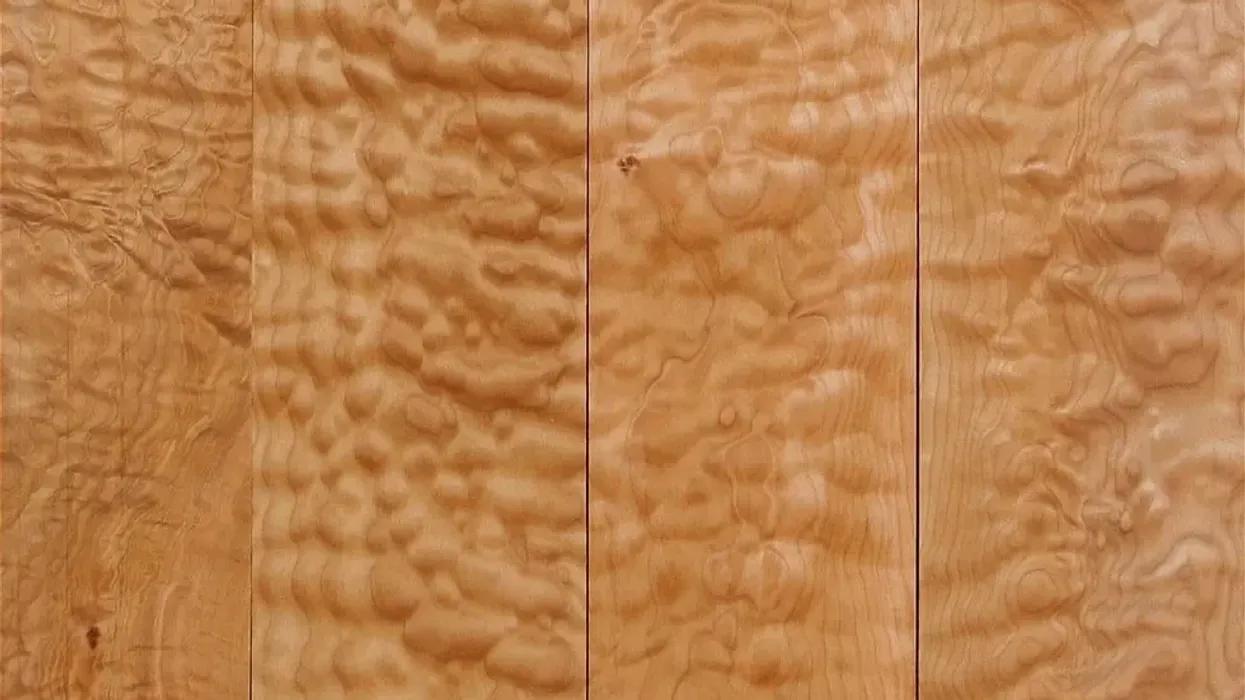
Hello, and welcome back to Mod Garage. You asked for it, and Mod Garage delivers. Today, we will start a new little series and play “custom shop on a budget” together. We’ll talk about what is really important for the amplified tone of an electric guitar and prove all of this on the living object. We’re going to take apart a budget electric guitar down to the last screw, and we’ll see what’s possible to make it an excellent sounding guitar, step by step. I encourage you to follow along by getting yourself a similar electric and working in parallel to the column.
For this first installment, let’s have a closer look at the never-dying, snake-oil-drenched urban legends about tonewood on electric guitars and establish some parameters for our experiment. It’s very important to understand that we are talking about tonewood on electric guitars and their amplified tone exclusively; tonewood on acoustic guitars is a completely different thing. The rules for electric guitars are not applicable to acoustic guitars, and vice versa. In general, the whole discussion about tonewood is full of misunderstandings, inaccuracies, conclusions by analogy, biasing, and, of course, marketing bullshit of all kinds. And, sadly, a lot of this has developed into accepted internet knowledge by way of unfounded rumors.
Is the wood of an electric guitar the deciding factor of how it will sound? Or does the wood have no influence on its tone? I submit a resolute “no” to both theses: The truth here is much more complex, and, as usual, lies somewhere in between these two points. So, let’s try to find out exactly where that is!
There is no plant genus or tree called tonewood on this planet. That’s simply a word that’s intended to describe woods used to build instruments of any kind. In the context of stringed instruments, tonewood usually denotes woods that are traditionally used to build guitars. In the case of electric guitars, woods like alder, ash, maple, rosewood, and mahogany fall into this category, most of which have been used since the earliest days of electric guitar building. Let’s take alder and maple, for example. There are more than 40 alder and no less than 150 maple subspecies. Are they all tonewoods or only some of them? If it’s only some, which ones count? Did Leo Fender define what alder, ash, and maple subspecies get ennobled to tonewood? Let’s take a short journey back in time and see what Leo Fender cooked up in the early ’50s at 107 S. Harbor Blvd., Fullerton, California.
For his first electric guitars, Leo Fender used pine for the body (is pine a tonewood as well?) and maple for the neck. He soon switched to ash for the body, but stayed with maple for the neck. Why did Leo Fender choose these woods? Certainly not because of any tonal qualities. Ash and maple are lightweight, strong, easy to work with, and they were available in large quantities for a cheap price at the time. They were the perfect selections for Leo’s mass-production plans. Gibson decided to go with mahogany and maple, but for different reasons that also had little to do with tonal qualities. What exact types of maple, ash, and mahogany were used by Fender and Gibson? Well, nobody knows exactly, and the most likely answer would be: whatever was available cheap and in large quantities. It’s likely that even their wood suppliers didn't know exactly what subtype they were offering! These woods were probably chosen because of structural, optical, and economic reasons, yet they laid the foundation of the tonewood legend in electric guitars.
Interestingly, our bass-playing colleagues seem not to be caught in such paradigms, and all kinds of woods are used to build fantastic sounding electric basses today without the tonewood debate. Try to build a great-sounding electric guitar using cherry, pear, chestnut, oak, or birch; I’d venture that most people will tell you that it doesn’t sound right because it’s not made out of tonewood.
Now that we’ve established what tonewood is, let’s talk about the actual tone of these woods. Here’s a common comparison of ash and alder: In general, ash tends to produce a brighter, more articulate tone with good sustain, while alder is known for its warmer, thicker midrange sound. Ash, especially swamp ash, is often described as having a sweet, open top-end with a slightly scooped midrange. Alder, on the other hand, is perceived as having more pronounced mids and a potentially less defined low end. Sound familiar?
Here again, we have the problem of missing definitions and inaccuracies: Does this mean all kinds of ash and alder sound the same, no matter what subspecies they are? Is there a kind of general ash or alder tone? Assuming we’re talking about electric guitars, what tone are we discussing—the primary tone when strumming an unamplified electric or the amplified tone? Tonal descriptions are usually missing this important information.
“The correct question should be: How much of these tonal differences will be audible in the electrified tone of an electric guitar? Is the amplified tone simply a 1:1 copy of the primary acoustic tone?”
I think we can all agree that using different woods and hardware has an influence on the primary tone of a guitar, no matter if it’s an acoustic or an electric guitar. A cedar soundboard will create a much different tone than spruce or mahogany on an acoustic guitar, and an alder body on a Strat will sound different than ash, maple, or mahogany when playing it unamplified—not to mention the tonal impacts of different types of hardware on the guitar. So, the correct question should be: How much of these tonal differences will be audible in the electrified tone of an electric guitar? Is the amplified tone simply a 1:1 copy of the primary acoustic tone? Well, let’s try to find out.
A common scenario you can observe in guitar shops and on countless YouTube videos is the mandatory “dry test” when checking out a new electric guitar. The electric guitar is played like an acoustic guitar without being plugged into an amp. You can hear a lot of different answers for why such a test is important: You can feel how the wood resonates, what sustain it has, what overall tone it has, how much high-end chime is present, what the attack is like, etc.
Interestingly, all too often, criteria like playability and comfortability, defining how the guitar individually suits you, are omitted. How does the shape of the neck, the size of the frets, and the edge of the fretboard feel? How does the shape of the guitar fit your body when seated and standing? How does it intonate, how is the action, and how heavy is it? All of these factors determine to what degree the guitar will be a part of you, just like buying new jeans.
But what about the countless claims that the elements you hear in the dry test will be heard through the amp, too? Are these overly simplistic conclusions reached by analogy mixed with confirmation bias—an all-too-human reasoning process? Well, we’ll see.
You will have noticed that I haven’t made a single judgement until now; I’m just collecting facts and asking questions, and I encourage you to think and research about all of these things yourself until next month.
That’s when we will continue and finish our journey through the fantastic world of tonewoods for electric guitars, so stay tuned!
Until then ... keep on modding!
OC Pedal Co. Introduces their New Guitar Pedal the LA HABRA Hard Clipper
OC Pedal Co. has released the company’s second pedal, the LA HABRA Hard Clipper. This distortion captures some of the classic 80’s and 90’s drive tones we know and love.
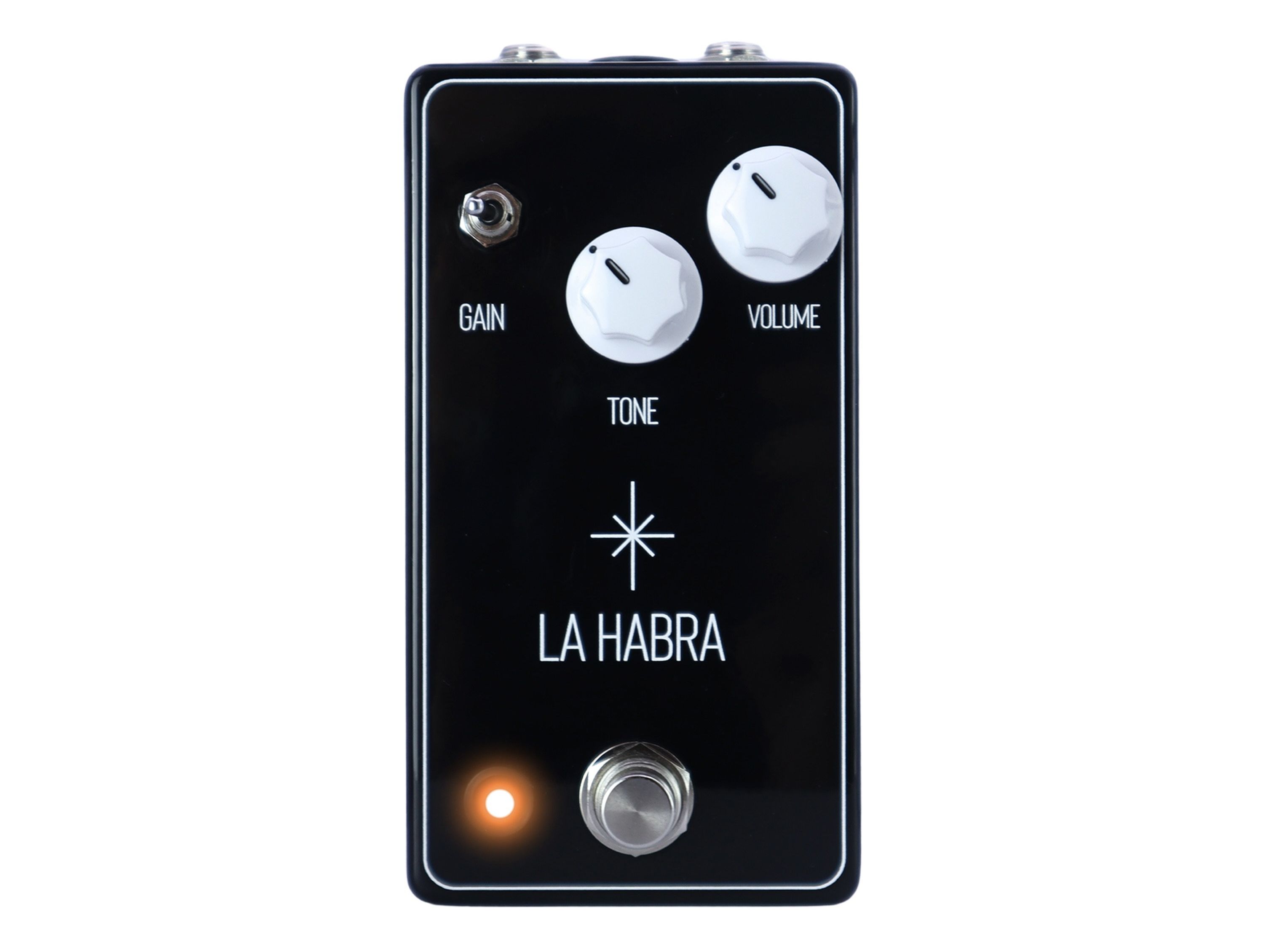
The LA HABRA Hard Clipper is heavy, but still organic in its touch response, it’s kind of like fuzz for people who don’t like fuzz! The pedal’s interface is simple, it features a master volume, tone knob and a gain toggle switch allowing players to change the character of the clipping. The gain level is fixed! This unit shines through clean pedal platform type amps.
Key pedal features include:
- 80’s/90’s distortion tones
- Stacks well with overdrives
- Two clipping profiles to change the character of the distortion
- True bypass on/off switch
- 9-volt operation via standard external DC input (no battery compartment)
- Top-mounted input/output/DC jacks for easy pedalboard installation
- Designed and assembled in USA
The OC Pedal Co. LA HABRA Hard Clipper carries a street price of $179 and is available direct to consumer at www.ocpedalco.com
Daron Malakian’s Scalding Hot Melting Pot

Daron Malakian doesn’t believe everything he writes should be recorded right away, and he doesn’t craft songs in front of a computer with a DAW. “I guess I’m old school that way,” he confesses. “I just sit with my guitar on my couch, and if I come up with a good idea I record it on my [smartphone] voice memo.” Over time, he’ll go back to those ideas, repeatedly, whenever he picks up his guitar. “I entertain myself that way, playing with it like a toy, and then, sometimes years down the line, I record it.”
-YouTube
Whether with System of a Down or his own band Scars on Broadway, Malakian’s melting-pot songwriting alchemy draws as much from his Eastern (Armenian) heritage as it does his Western (American) influences. This unforced approach to songcraft has been at the heart of his success ever since he burst onto the scene with System of a Down’s eponymous debut in 1998. System released Toxicity in 2001, featuring their controversial, breakout single “Chop Suey!” and the epic, requiem for life’s meaning, “Aerials.” In 2005, they released two albums, Mezmerize and Hypnotize, the former featuring “B.Y.O.B,” which earned them a Grammy Award for Best Hard Rock Performance. For a band that only released five full-length albums between 1998 and 2005—three of which debuted at No. 1 on the Billboard 200—System of a Down sure left an indelible imprint on hard rock and heavy metal with their socially provocative lyrics and drop-tuned guitar manifestos.
Malakian launched Scars on Broadway and released their self-titled debut in 2008 largely because System had become inactive. In 2018, he issued Dictator, simultaneously rebranding the outfit as Daron Malakian and Scars on Broadway, citing the fact that he envisioned a rotating cast of musicians rather than a singular lineup. The third Scars album, Addicted to the Violence, dropped on July 18. On each record, Scars delivers lyrics that are in line with the social themes that fuel System’s worldview. Musically, however, Malakian doesn’t seem bound by genres or interested in recreating the success of past endeavors. The binding ingredient in his sound is simply to be honest as an artist.
“I have to be open to using whatever colors the song is asking for.”
“I’m going to make a Beatles reference, but I always want to be careful,” he clarifies. “I’m not putting myself on their level, but when you listen to the Beatles and you hear, [sings] ‘Michelle, ma belle…,’ then ‘Helter Skelter,’ then ‘Ob-La-Di, Ob-La-Da,’ it shares the same DNA, but it’s so different stylistically. I’m not saying I achieved that on the same level, but I like artists that go through phases.” He cites Iggy Pop’s The Idiot, produced by David Bowie, as a prime example. “When you listen to that album it’s just so different from the Stooges. Having said that, the Ramones kept the same formula, and I freaking love the Ramones, so nothing against those guys, but it’s not what I do.”
Take “The Shame Game” on Addicted to the Violence. After the up-tempo, aggressive, one-two-three socio-political punch of “Killing Spree,” “Satan Hussein,” and “Done Me Wrong,” the mid-tempo song drops in, grabbing the listener’s attention with a dark, foreboding guitar part that completely shifts the tenor of the album, from heavy-on-the-riffs cultural insanity to mid-tempo atmospheric musical empathy. It’s an epic detour that enhances not only the track listing but exemplifies the yin and yang of Malakian’s songwriting, whether it’s the back and forth between mid- and up-tempo numbers or the amalgam of emotions and influences present in any given tune. Most importantly, “The Shame Game” reflects his patience when it comes to crafting a song, and is a great example of how Malakian can sometimes spend years toying with an idea.
“I used to start that song with the vocals: [sings] ‘Ain’t no shame in your game,’ but I was never really happy with it,” he explains. “I even recorded it that way when I first started working on this album during the pandemic.” One day, while sitting with his guitar in his living room, the intro 6-string part spilled out. “I didn’t even really come up with it for ‘Shame Game,’” Malakian admits. “But when I put it there, it completed the song. And that only happened years after I wrote the bulk of the tune.”
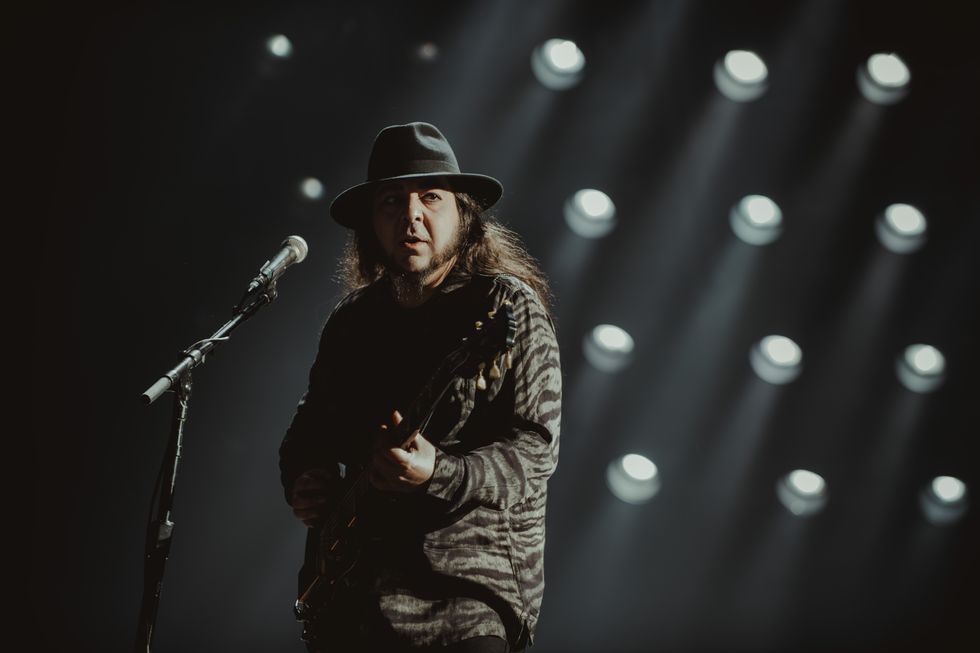
Malakian practices this unobtrusive approach to songcraft not by imposing his ego onto his ideas, but rather by allowing the song to tell him what it needs. “If I didn’t have moments like ‘Shame Game’ or ‘Addicted to the Violence’ or ‘You Destroy You,’ it wouldn’t feel like me,” he explains, citing three songs from his new album that most embody his Armenian upbringing and broad musical palette. “I can’t just pick three colors and say, ‘I’m only going to use these colors for this piece of work.’ I have to be open to using whatever colors the song is asking for. Sometimes it’s going to be heavy and you’re going to want to mosh, sometimes it’s going to be emotional and you’ll want to sing along, and sometimes you’re going to laugh because it’s freaking ridiculous and funny and kind of stupid. And those are all the sides of human emotion I’ve always tried to express in my writing.”
Malakian’s view is that he is merely channeling whatever it is the universe has to offer, and his lack of an agenda creates the necessary space for the creative juices to flow. It’s one of the reasons he gives the songwriting process time. “I just let things happen very naturally, and whatever sticks with me, sticks with me,” he attests. “Sometimes I don’t even feel responsible for it, like, ‘How the fuck did that just come out of me?’ Everything I do is subconscious.” When System first came out, for example, he says people would often focus on the Armenian influence in their music. “We were like, ‘We’re really not trying to write like that.’ It’s just part of the culture we’ve been around, so it’s bleeding into what we’re doing without us really trying to make that happen. It just happens.”
Daron Malakian’s Gear
Guitars
1962 Gibson Les Paul SG Standard
1968 Gibson ES-335
Amp
Dave Friedman-modded ’70s Marshall JMP100
Effects
Boss DD-6 Digital Delay
MXR M101 Phase 90
Strings and Picks
Ernie Ball 2215 Skinny Top Heavy Bottom (.010–.052)
Jim Dunlop Delrin Triangle .96 mm picks
Malakian grew up in Los Angeles and went to an Armenian private school, where he also attended church. It was there he first got into music, via singing, long before picking up a guitar. “I would sing Armenian church-chant kinds of things,” he recalls. He subsequently wrote a lot of the melodies in System of a Down (“Serj [Tankian, System lead vocalist] might be singing them, but I wrote a lot of those vocal lines”), and is the main lyricist and singer in Scars. His family lived in a small apartment when he was an adolescent, so he couldn’t have any loud instruments. He actually wanted to be a drummer, but didn’t get his first instrument until his family moved into a house when he was 11, and he finally got his own bedroom. “Guitar happened by accident,” he says. “I’m happy that it happened, but my parents didn’t buy me a drum set because you couldn’t turn it off. [laughs] To this day, I’m more interested in vocalists and drummers than I am guitar players.”
“I actually have to stretch myself to get bluesy.”When Malakian’s parents did eventually buy him a small amplifier and a guitar, he says, “I was like, ‘Alright, this is what I’ve got. Let me see what I can do with this thing.’” He spent hours in his room playing, but instead of focusing on guitar chops, songwriting became his passion. “I found my own voice through writing songs,” he recalls. He’s so song-driven, in fact, that he wrote much of the first Scars record primarily using synthesizers and drum machines, which imbued the early demos with “electronic-goth vibes.” When he assembled a band, he introduced those songs to the unit with his guitar. “Songs like ‘Funny,’ ‘They Say,’ ‘Whoring Streets’ [from Scars on Broadway], and even ‘Guns Are Loaded’ [fromDictator] were all written on synthesizers before becoming guitar-driven rock songs,” he admits. When he transitioned them to guitar for band rehearsals, he says, “I found myself playing things that I wouldn’t have come up with had I come up with them on the guitar.”
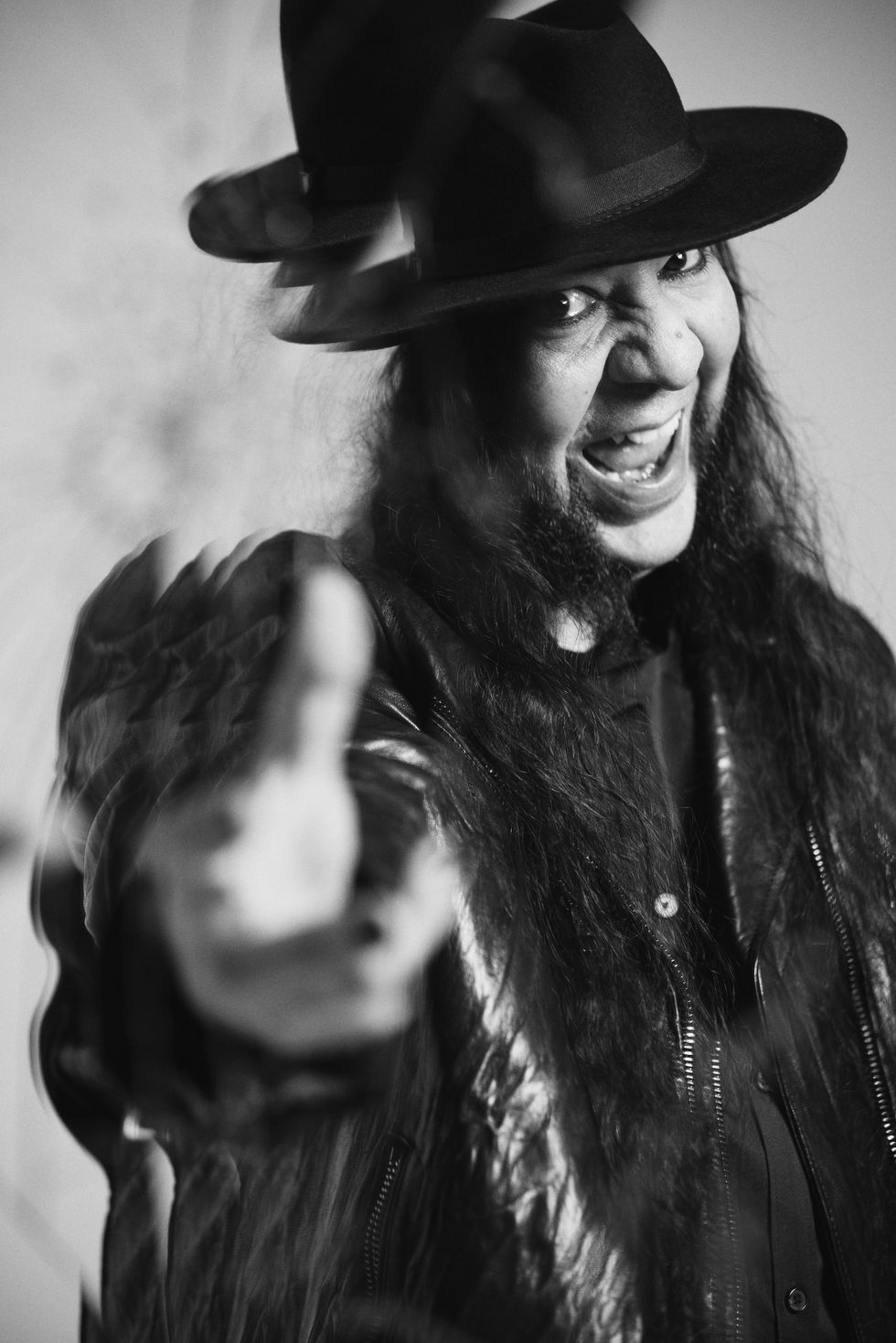
The solo in “Done Me Wrong” is an example of how the Armenian influence can seep into Malakian’s songwriting with a bit more intentionality, and that it’s not necessarily the guitar that needs to be the focal point of his tunes, even when soloing. “The solo that you hear in the middle of the song, that keyboard, synthesizer-style, is the type of solo that you’ll hear in Armenian wedding-pop-dance music,” he explains. “I co-wrote that song with my guitar player, Orbel Babayan, and it drives very much like Deep Purple in the way that the rhythm moves. And like Deep Purple, we wanted that kind of solo, not in a neoclassical way, but more like what we call ‘Rabiz’ in Armenian music.”
Malakian says that blues-rock-based riffs and motifs don’t come as naturally to him as they would to someone who was raised on American rock ’n’ roll. Conversely, styles like Rabiz do come more naturally to him than they might to your average Westerner. “I actually have to stretch myself to get bluesy,” he admits. “That’s just because of where my family comes from and the community that I grew up in. But I was born and raised in the United States, so I was influenced by rock, metal, and pop radio, too.”
“I always tell people when you put out an album it’s forever.”
Ever since System’s Mezmerize and Hypnotize albums, Malakian has pretty much kept the same “heavy” guitar tone for recording. His main amp is a Dave Friedman-modded Marshall 100-watt JMP100 from the ’70s. For guitars, he relies on his 1962 Gibson Les Paul SG Standard and a 1968 Gibson ES-335. “We had the fires in L.A. back in January, and I had to evacuate,” he recalls. “I left all my guitars except for those two. I cannot replace them.” For recording, he generally stacks those guitars on top of each other. “The semi-hollowbody just explodes sonically, so I often use that for my heavy tone.” During System’s heyday, he layered a lot of guitars on top of each other, but with Scars, he doesn’t. “On this record, I didn’t really bust out a million guitars,” he says of Addicted to the Violence. He doesn’t employ many effects, either. “Sometimes I’ll use a phaser or a delay, but I’ve never been that crazy about using effects.” A hallmark of Malakian’s guitar sound is the crispness and crunchiness of his rhythm tone, a testament to these vintage axes and his minimalist approach.
Malakian’s early relationship with Rick Rubin, with whom he co-produced System of a Down’s albums, also had a significant impact on his songwriting and record-making ethos. “I’ve never had another producer aside from Rick Rubin, so his production style is what I bring to my mindset—it’s not technical at all,” he explains. “He’s someone who guides you on a journey and gives you advice.”
When Malakian wrote “Lost in Hollywood” [from Mezmerize] and brought the song to the band, Rubin looked at him and said, “It’s good, but it’s not finished.” Malakian recalls, “I thought it was finished, but that night I got home and that whole middle section came out of me. [sings] “I was standing on the wall, feeling 10 feet tall…’ It came out of nowhere.” Now, he says, he can’t even imagine the song without that part. “It’s the best part of the whole fucking song,” he attests. “Did he turn a knob? Did he fine-tune my guitar sound? No, but he made my song better just by giving me a little nudge and saying, ‘I don’t think it’s finished.’ I hear some people have experiences with Rick and they’re like, ‘He didn’t do anything.’ If you want your hand held through the whole fucking process and someone to sit there to be your motivation while you’re doing your guitar tracks, he’s not that guy.”
At this point in his career, Malakian has the luxury of not having to shoehorn his creativity into record company deadlines or marketing campaigns. He likens his artistic mindset, which leans towards capturing moments of divine inspiration, to preparing a meal. “I always tell people that when you put out an album it’s forever,” he says. “And because it’s forever, I don’t mind taking forever to finish that thing that’s going to be forever. You don’t serve a meal until it’s done cooking. And I’m in no rush.” He laughs. “It’s done when it’s done, and it will taste better to you that way.”
YouTube
Listen to Daron Malakian and Scars on Broadway’s Addicted to the Violence in its entirety.
Amyl and the Sniffers Rig Rundown with Declan Mehrtens & Gus Romer
Declan Mehrtens and Gus Romer brought the heat for the punk quartet’s storming spring headline tour.
Australian punks Amyl and the Sniffers have had a pretty good year. In October 2024, they released their third full-length, Cartoon Darkness, and opened a run of North American shows for Foo Fighters. This year, they warmed up the stage for the Offspring for a handful of shows in Brazil, then tore off across the United States and Canada for a headlining tour.
Ahead of their stopover at Nashville’s Marathon Music Works, PG’s Chris Kies met with guitarist Declan Mehrtens and bassist Gus Romer to see what weapons the Aussie invaders are using to conquer the music world.
Brought to you by D’Addario
300 Club
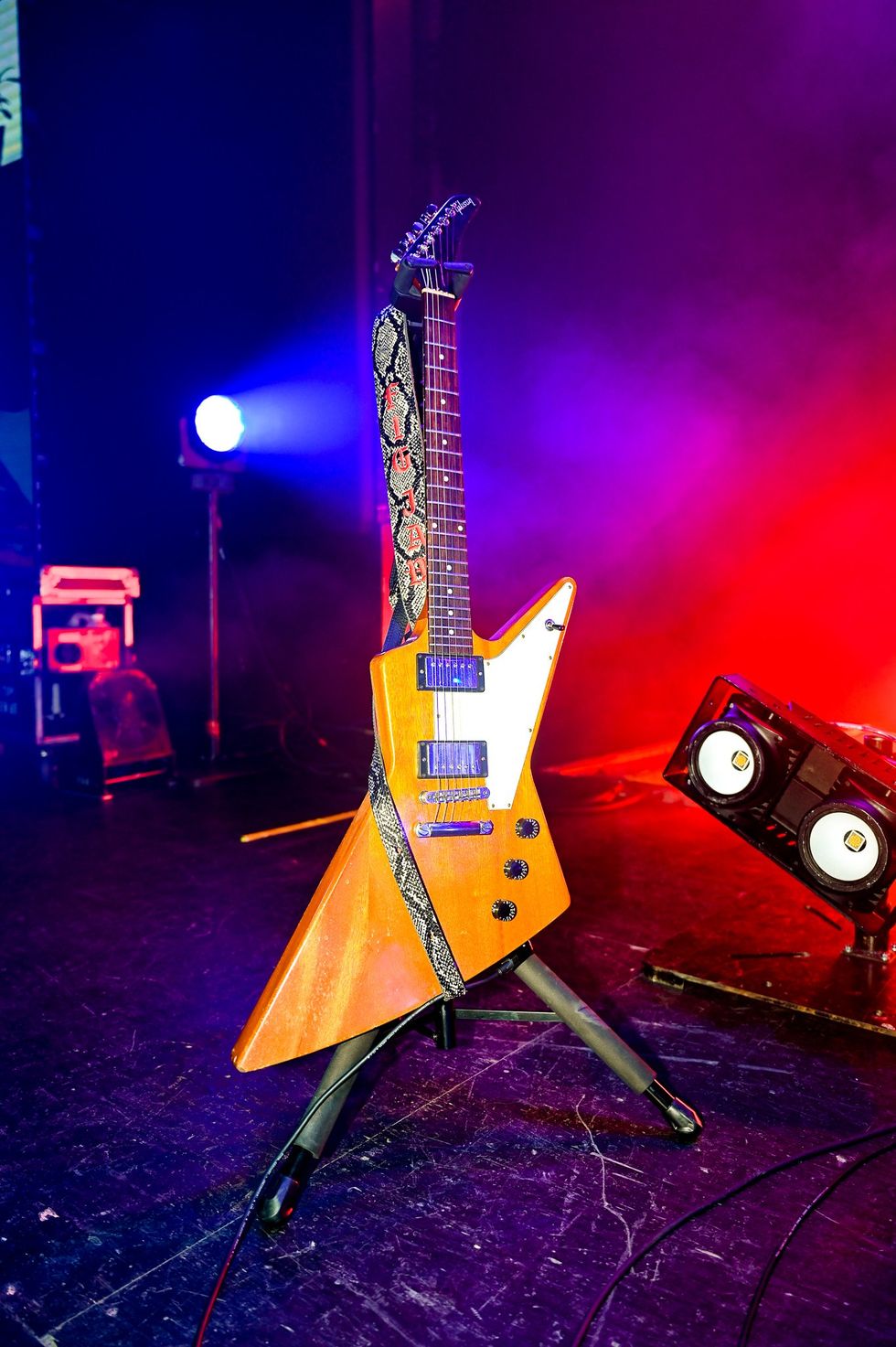
Mehrtens reckons he’s played around 300 gigs with this trusty Gibson Explorer, and it was used on just about every track on Cartoon Darkness. While recording, he equipped it with flatwound strings and a Lollar P-90 pickup in the bridge, but for tour, it’s got a Seymour Duncan Saturday Night Special in the bridge in addition to its stock neck pickup. It’s tuned a half-step down, and an identical (though less beat-up) Explorer is on hand in case this first one goes down.
Deluxe Dreams
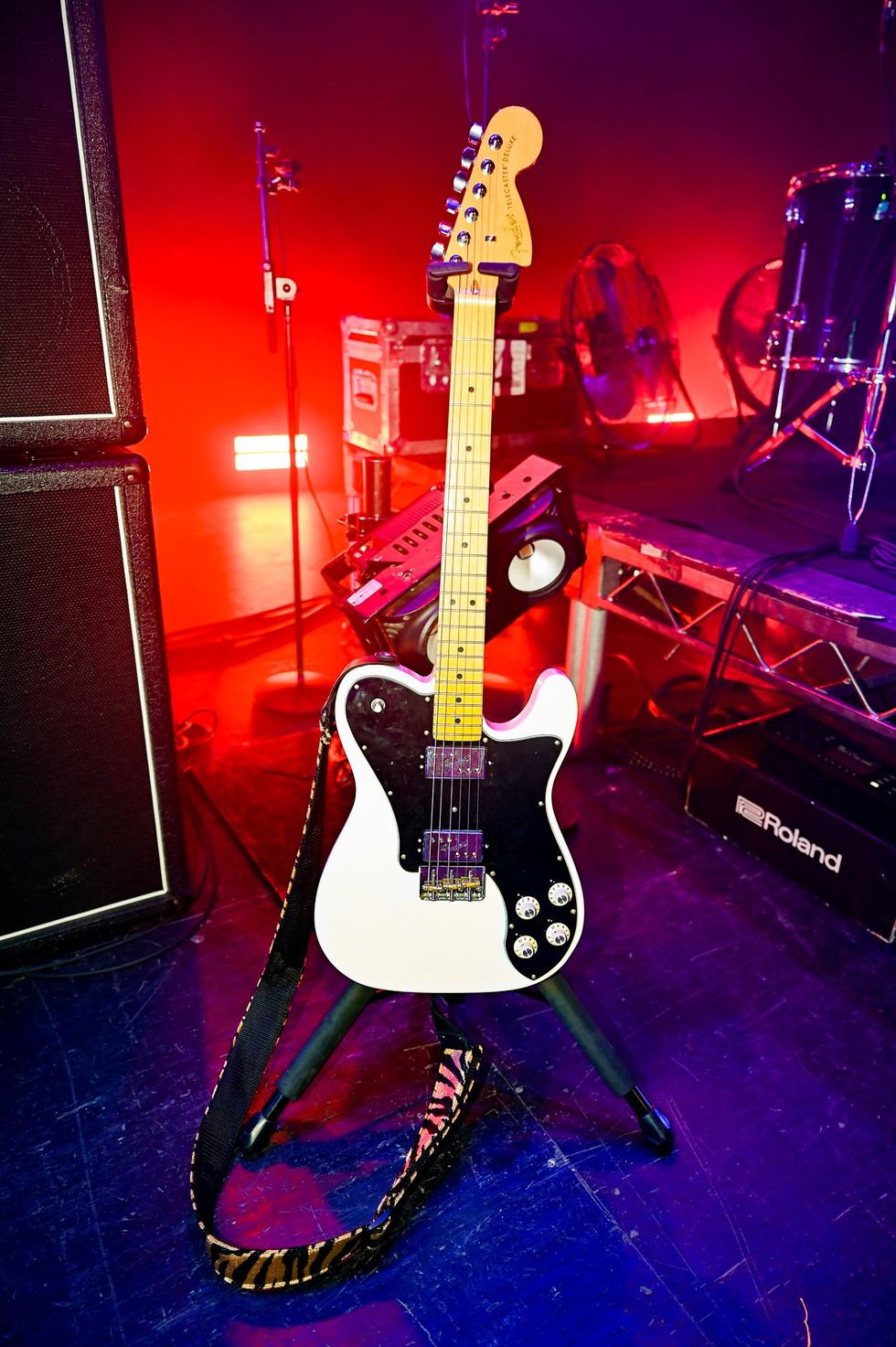
This Fender Telecaster Deluxe comes out for the set’s softest song, “Big Dreams.”
Marshall and Friends
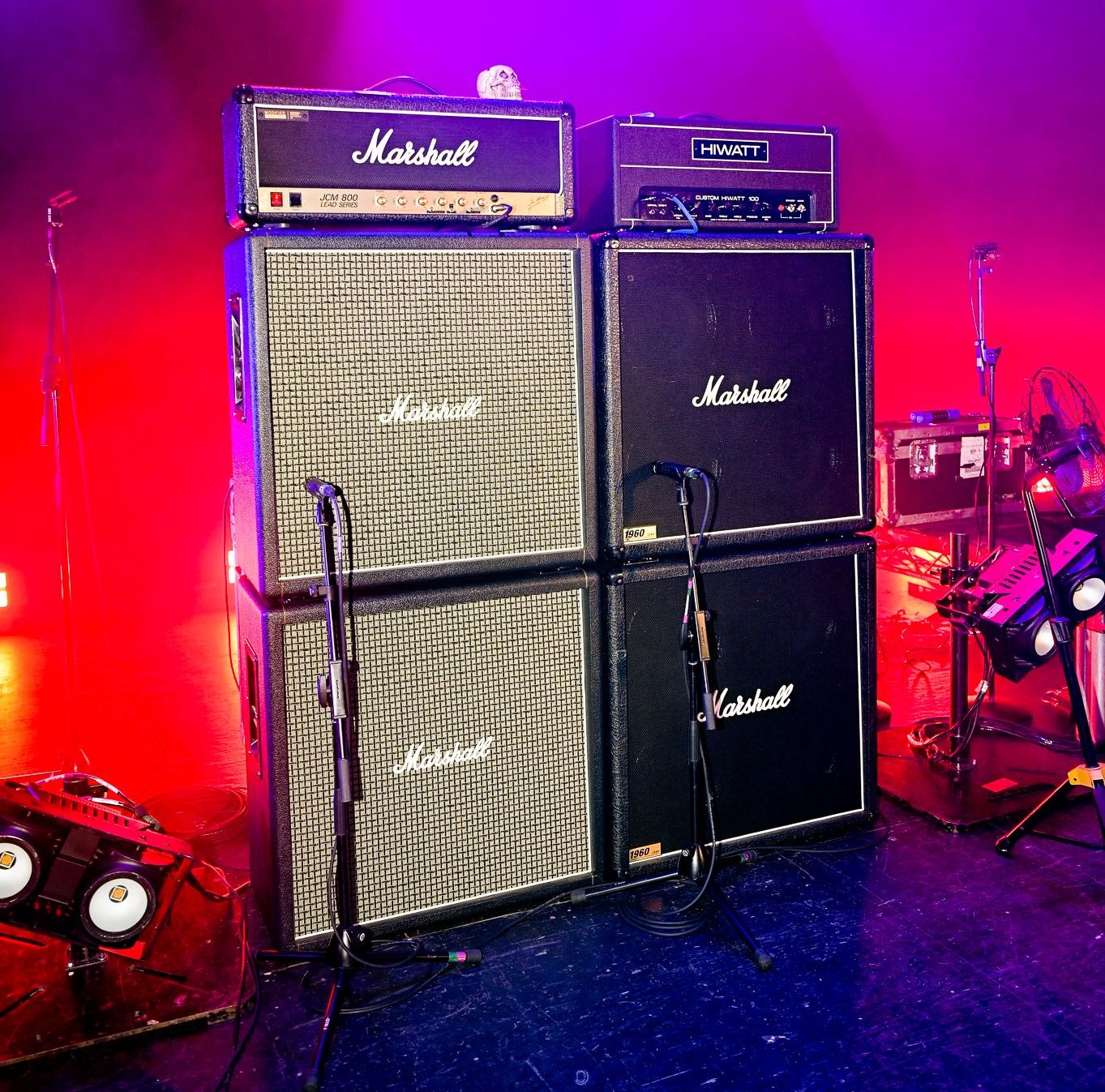
In addition to his beloved JCM800, Mehrtens is running a Hiwatt Custom 100, a model he discovered in Foo Fighters’ studio. Both are dialled in for a general-purpose rock tone, and an always-on Daredevil Drive-Bi, kept behind the stacks, runs into the Hiwatt to push it into breakup.
Declan Mehrtens’ Pedalboard
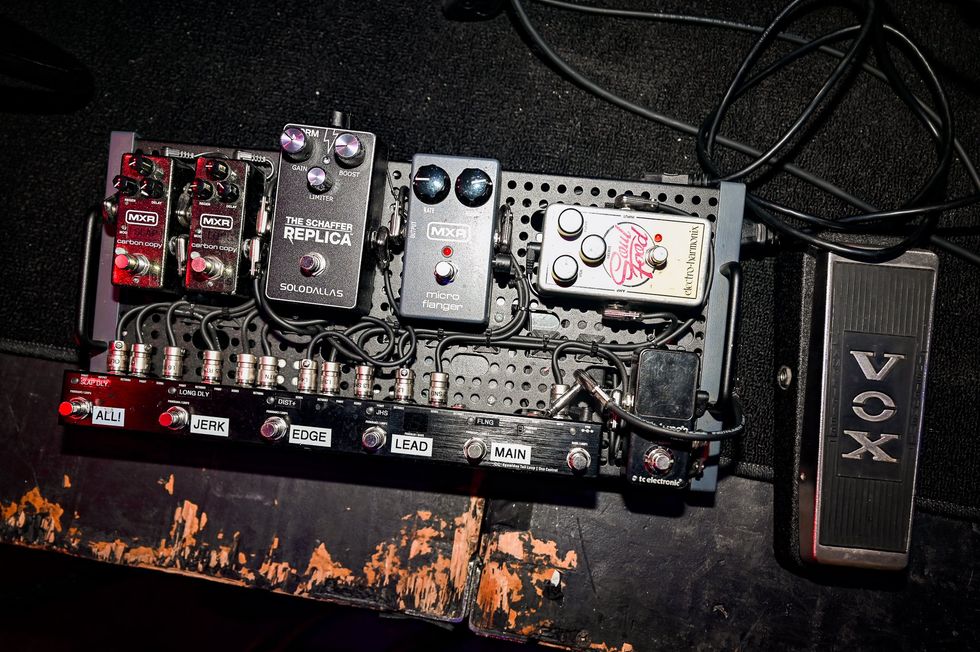
The jewel of Mehrtens’ board is his SoloDallas Schaffer Replica, famous for its recreation of Angus Young’s guitar tone. In addition, he runs a TC Electronic PolyTune 3 Noir, Electro-Harmonix Soul Food modded with LED diodes, MXR Micro Flanger, two MXR Carbon Copy Minis, and a Vox wah pedal. A switcher with six loops, built by Dave Friedman, manages the changes.
P for Punk
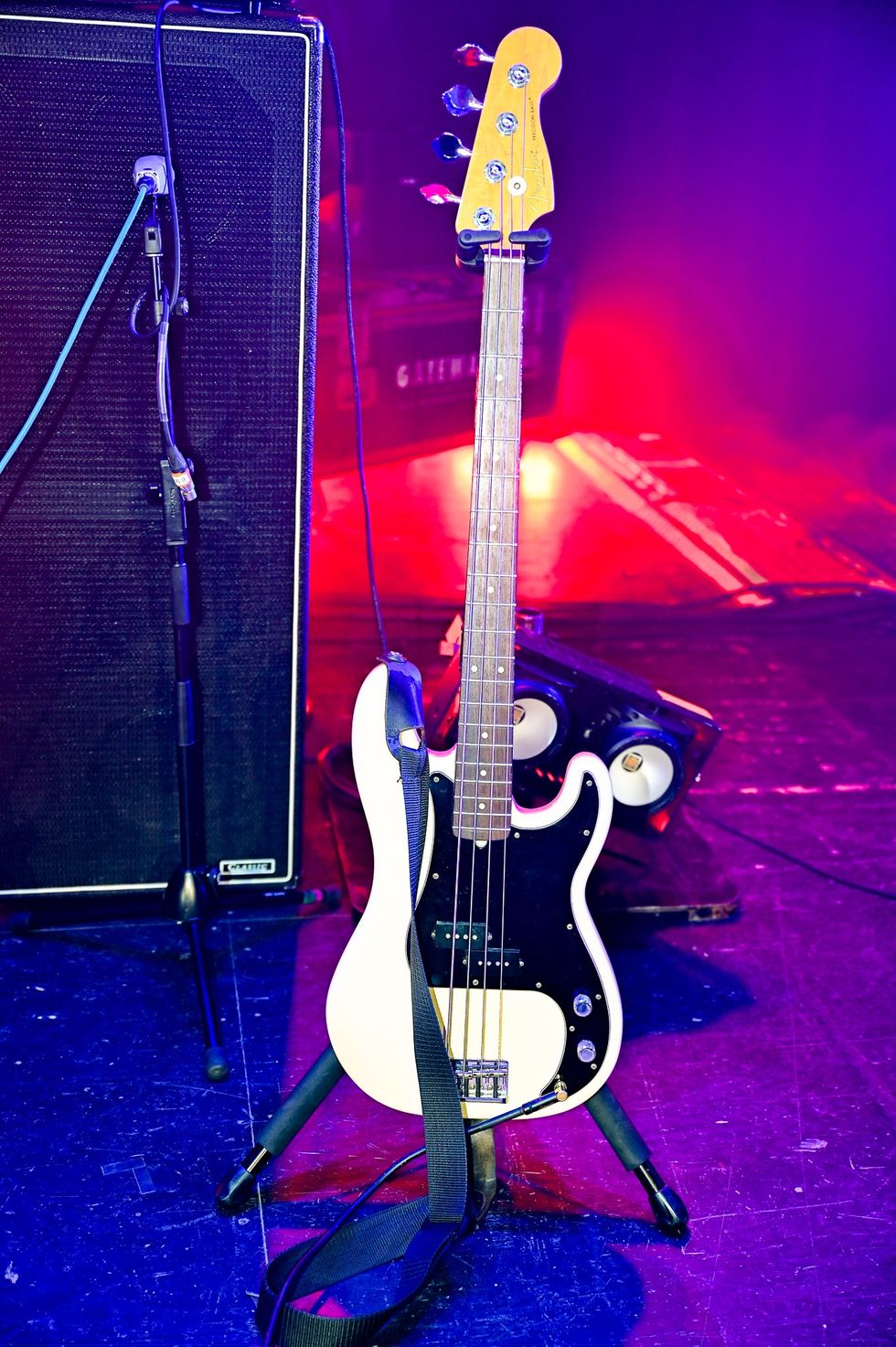
Romer plays this Fender Precision Bass, which is either a 2023 or 2024 model, though he insists the “P” in P bass stands for “punk.”
Three-Headed Beast
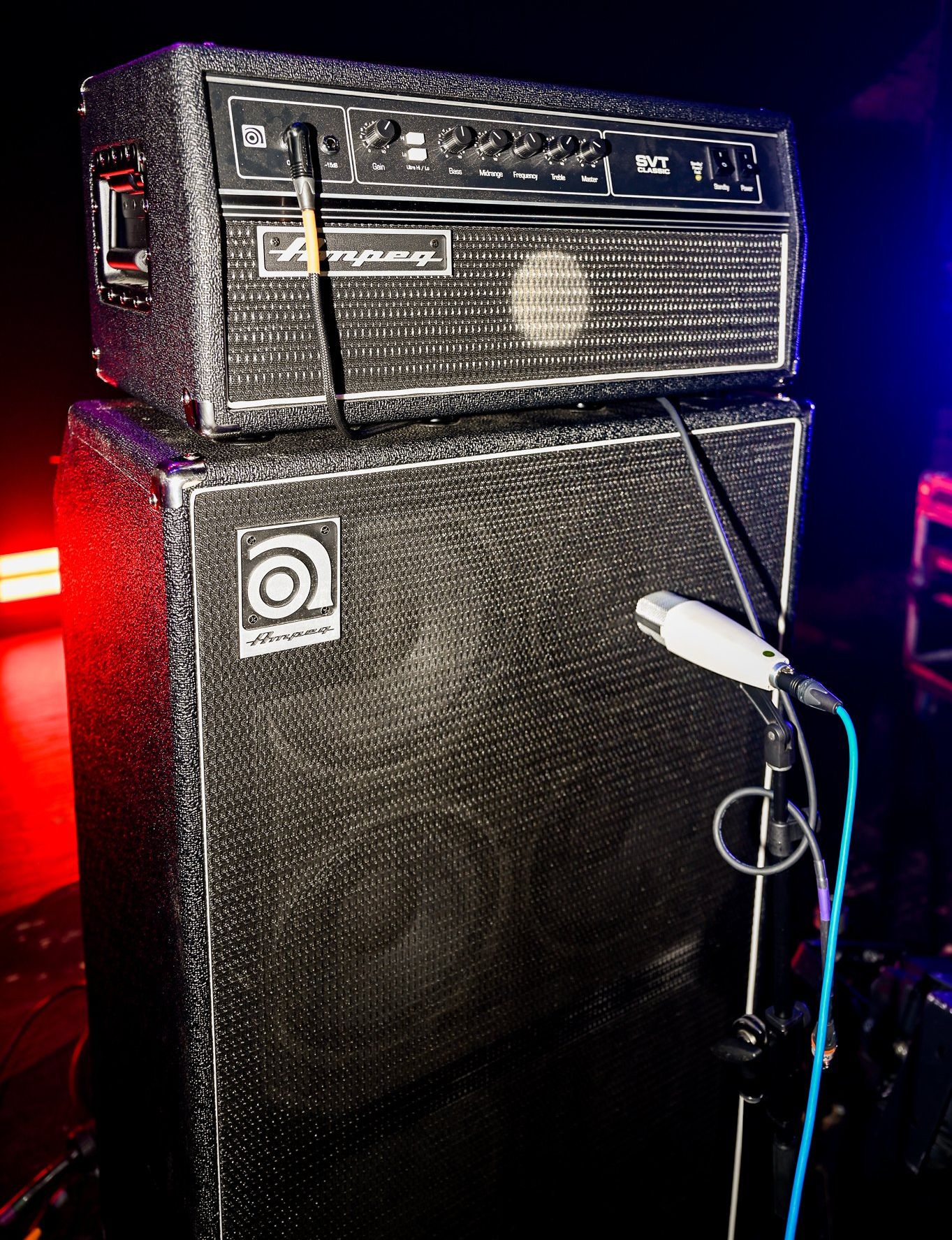
Romer’s signal is split into three channels: One split comes after his tuner, and runs clean to front-of-house, another channel runs direct and dirty from this Ampeg SVT Classic, and the last runs through his cabinet into a Sennheiser MD 421.
Gus Romer’s Pedalboard
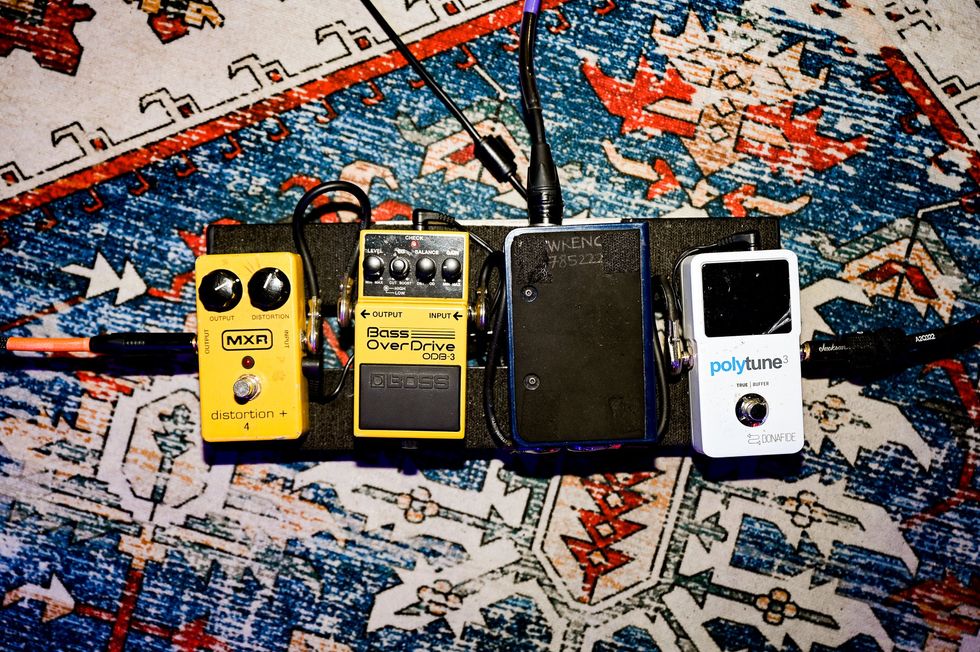
Romer’s board, furnished with the help of Mehrtens, gets right to the point: It features a TC Electronic PolyTune 3, a Boss ODB-3, and an MXR Distortion+.

Gibson Explorer
Fender Deluxe Telecaster
Marshall JCM800
TC Electronic PolyTune 3 Noir
MXR Carbon Copy Mini
MXR Micro Flanger
EHX Soul Food
Vox wah pedal
Boss ODB-3
MXR Distortion+
TC Electronic PolyTune 3
Fender Precision Bass
Ampeg SVT Classic
Seymour Duncan Saturday Night Special
Asheville Music Tools Analoger APH-12 Review
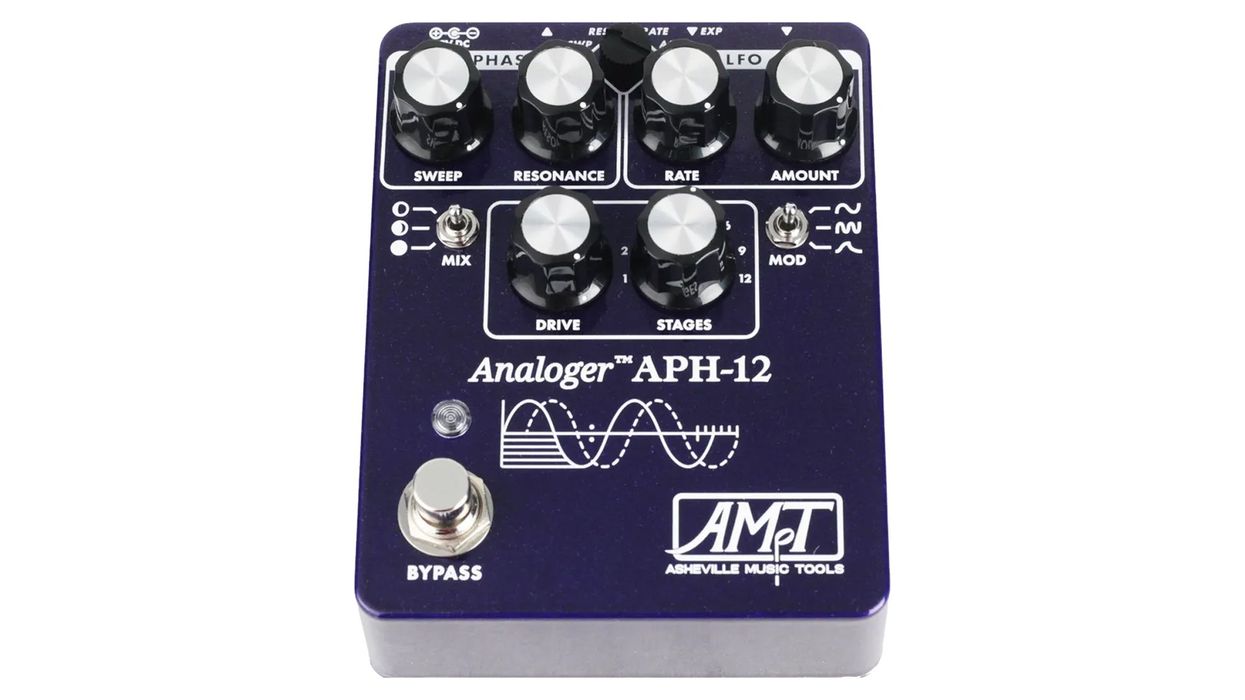
At the end of the very thorough—and essential—manual that accompanies the Asheville Music Tools APH-12 phaser, designer Rick “Hawker” Shaich sweetly dedicates the pedal to the memory of the Grateful Dead’s bassist Phil Lesh. In fact, there are several references to the Dead in the manual—most pertaining to the APH-12’s ability to mimic Jerry Garcia’s envelope filter tones. But it is probably Lesh, the Dead’s relentless experimentalist, that would have appreciated the impressive, immersive APH-12 the most. Because while the all-analog APH-12 excels in rich conventional phaser sounds, it is capable of radical filtering and EQ effects, vibrato, tremolo, ring modulation, and more that would have been right at home on 1968’s Anthem of the Sun, the Dead’s mad-scientist production apotheosis. But you certainly don’t need to be a Deadhead to appreciate the sounds and craft that distinguish the APH-12. If you dig peppering your own productions and compositions with distinctive, weird, arresting textures—or just buttercream-thick phaser sounds—the APH-12 is a feast of treats that can transform a tune.
12 Stages, Infinite Roads
The fact that Hawker once worked as an engineer for Moog is a less-than-well-kept secret. And it’s impossible to not be excited about the APH-12 in the context of the Moogerfooger MF-103 phaser, a Bob Moog modulation masterpiece that Hawker helped refine during his tenure. With its 12-stage capability, drive control, and LFO section, many aspects of the APH-12’s features and functionality mirror those of the MF-103. But the APH-12 has a very different architecture. Where the MF-103 featured just 6- and 12-stage phase effects, the APH-12 is capable of 2- and 4-stage phasing as well as single-stage and odd-numbered staging that yield unusual, colorful out-of-phase effects. It also features an envelope-controlled mode that enables dynamic command of the modulation.
Learning how all these functions work together takes time. Though Hawker initially conceived the APH-12 as the company’s first analog/digital hybrid pedal, his ears led him back to an all-analog design. That means you can’t rely on presets to capture sounds derived from sensitive and interactive controls. You have to pay attention and probably take notes. But the process of decoding the APH-12’s secrets is instructive, engaging, immersive, and intuitive in its way, and learning its language is addictive stuff that often yields musical gold.
You Can Always Go Home
Though it’s easy to get into very strange places with the APH-12, getting back to a safe space is as simple as selecting the 1-, 2-, 4-, or 6-stage phasers and backing off the phase amount, LFO resonance, and sweep controls. The latter, which adjusts the center frequency for the modulations, effectively works like a tone control, taming and enhancing peaks that can make a phase cycle super intense or subtly woven through the fabric of a musical phrase. It’s not only easy to return to these more modest phase effects if you get lost in the weeds, but they are deeply satisfying and, in terms of depth and character, rival or better my own favorite phasers. This capacity for thick, rubbery versions of classic 4- and 6-stage phase controls is enough to make a case for replacing every phaser in your collection with the APH-12. But it’s the pedal’s ability to deliver the unexpected that makes the hefty near-$400 price tag a value.
The odd-numbered stages, for example, are as impressive for their filtering effects as modulation. In the single-stage mode, the modulations can double as tremolo pulse, but the frequency cancellations lend a dirty ’60s attitude to guitar lines that would serve one of Sergio Leone’s grittiest spaghetti Western scenes. The 3-stage setting is home to some of my favorite colors in the APH-12. It can sound nearly as chewy as the 4-stage setting, but has a funky, vowel-ly attack that bridges the gap between Funkadelic and Pink Floyd and, for its narrower tone emphasis, sounds more focused in a multi-instrument mix.
“This capacity for thick, rubbery versions of classic 4- and 6-stage phase controls is enough to make a case for replacing every phaser in your collection.”
The 5-stage mode, like the 3-stage setting, is home to some of the most Garcia-like tones, especially when used with the dynamic envelope setting on the modulation switch. But in 5-stage mode you also start to hear more pronounced variations on the APH-12 and the most mold-breaking tones. Here you’ll find modulations that are both elastic and vocal but also effectively lo-fi in a distant radio broadcast kind of way. This tendency is beautifully enhanced in 9-stage mode, and you’re likely to find a lot of sound designers lurking here, crafting dark submarine resonances and the atmosphere of chains clanking in an empty, hulking space freighter.
The odd-number modes aren’t all, well, odd. Slow-motion phase cycles with a heap of drive (which uses a JFET saturation stage to enhance even-order harmonics) can produce dreamy filter sweeps that are super-dramatic without being sprawling and bossy. The APH-12’s 12-stage mode is another place where sound designers and players seeking simple but pronounced coloration will co-exist. Here again, the APH-12 excels at shaping intense modulations that can be slotted surgically in a mix. But I was also able to construct tone environments equally well suited for a David Lynch-led field trip to trans-dimensional realms populated by metallic seagulls, distant throbbing motors, and fragments of fractured interstellar communications.The Verdict
The sounds highlighted here are a fraction of what the APH-12 can do. And while there are significant differences under the hood, anyone who has been thwarted in the secondhand Moog MF-103 market will find much to sate their hunger here. But outside any comparisons to a discontinued classic, the North Carolina-built APH-12 is an outstanding modulation, filtering, and noise machine that can bring the weirdness and the ruckus one second and slide back into slippery, sonorous, rich, and gliding phase tones in the next. It’s an expensive pedal, but you could replace multiple phasers and noisemakers sitting in your closet with this and never miss them—unless you get a hankering for your Phase 90’s one-knob, no-brainer simplicity. Factor in the considerable R&D and the many years of engineering experience behind the execution of this fine modulator and that $397 price tag starts to look like a very fair price—and a smart investment—indeed.
Legendary Punk Band Propagandhi’s Fight to Be At Peace

Winnipeg band Propagandhi’s new record was fully written when bassist Todd Kowalski showed up to a rehearsal with a rough, weird demo of a slow, lurching metal song. Vocalist and guitarist Chris Hannah, who splits principal songwriting duties with Kowalski, was pissed. “I’m like, ‘For fuck’s sake man, at the eleventh hour? Are you serious? Another song and one where I have to learn a new guitar technique? Whatever.’” The band—Kowalski, Hannah, drummer Jord Samolesky, and guitarist Sulynn Hago—began playing the song, which is now called “Guiding Lights,” and within a short time, Hannah realized that they’d just found the opening track for their new album. “You never know how something’s gonna unfold,” he says, “and you have to remain open to changes as the writing goes along.”
At Peace is Propagandhi’s eighth full-length, and their first in eight years, after 2017’s Victory Lap. It features some of their more experimental compositions, like the aforementioned opener, and the prog-metal ballad “Stargazing,” which is one of the gentlest songs in Propagandhi’s almost 40 years together. There’s the slowed-down hard rock of “No Longer Young,” and the sort of late-career downtempo metal of “Benito’s Earlier Work” and “Day By Day.” There are doses of skate-punk, thrash, and melodic hardcore here, too, but At Peace certainly marks a new speed for Propagandhi.
“We almost pushed ourselves in the opposite direction that we usually push ourselves,” says Hannah. “We’re usually looking for ‘frantic and dense, out of control.’ This record, we thought, ‘We’re going to push ourselves in the opposite direction, out of our comfort zone, into under-control, lots of space, room for things to bloom.’ For us, that meant slowing down.”
“I was working on just being able to play simple, mechanical things at much slower speeds. I realized when I did it for a long time, and I got okay at it, when I sped it up, it was so much better.”The tempos of some of the songs on At Peace were uncomfortably slow. For decades, Propagandhi has been a band that either plays fast or really fast, and Hannah simply didn’t know how to play riffs at much less than breakneck speed. Judas Priest’s 2018 record Firepower was an energetic inspiration for the new approach. “There’s an essence to that record that I think we were all hoping to evoke in writing these songs,” says Hannah. “It’s not an aesthetic thing, like we don’t have any of the ornamentation or performance capabilities of the guys in Judas Priest, but we wanted to honor something that we heard in that record, and I think that drove us to dial things back a bit and open it up. It harkens back to the music we first were inspired by in the ’80s, like the thrash-metal scene. The sense that you are being vaulted into outer space by the performance of the band was really important to us, but those bands also were able to control things.”
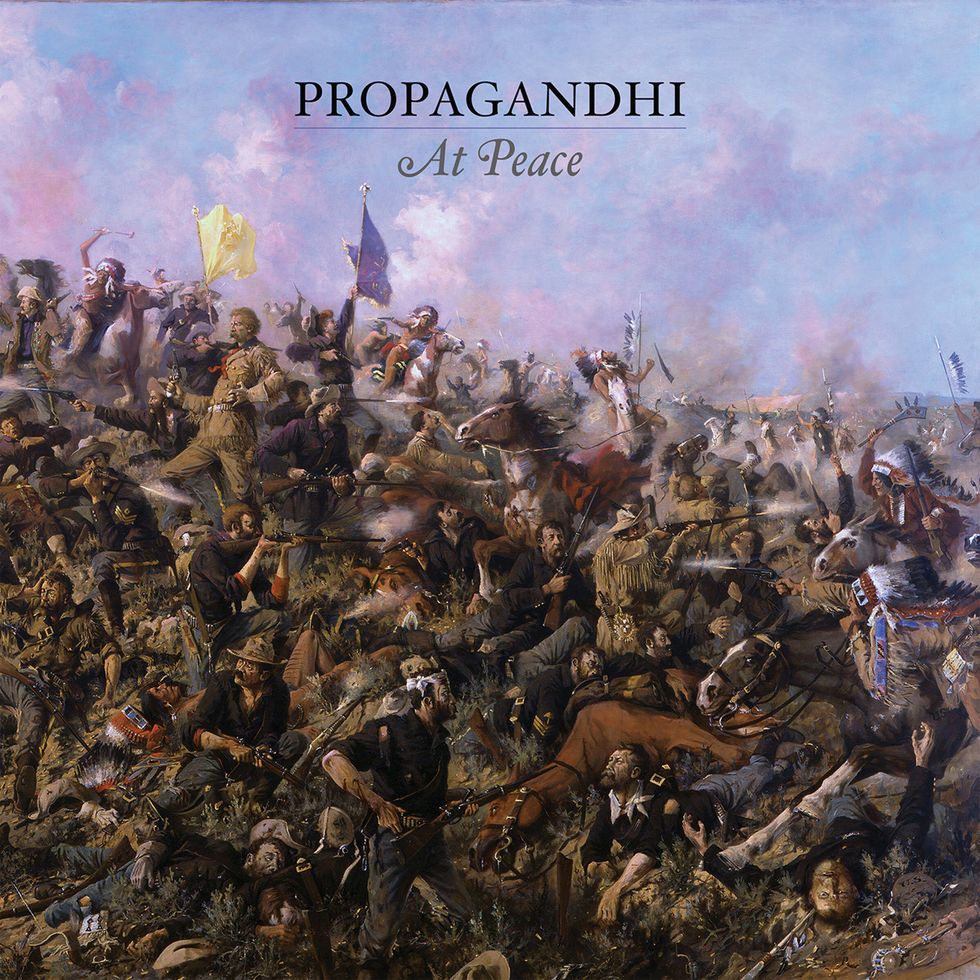
The downshift was especially difficult for Hannah. He never had a guitar teacher growing up, so he’s always figured things out for himself. That means that now, in his 50s, he’s still trying to correct “bad” techniques that he’s developed over the years. One of them is playing too fast. When Hannah comes up with a high-velocity riff now, he sets a metronome and tries to play it at half speed. The point is to determine if the phrasing is still intelligible; if it’s not, he’s not playing it right when it’s at full speed, either. “I was working on just being able to play simple, mechanical things at much slower speeds,” he says. “I realized when I did it for a long time, and I got okay at it, when I sped it up, it was so much better. In the course of doing that, sometimes you discover the slower speed is actually better. The stuff you’re trying to do gets more of a chance to be heard instead of just blowing by everybody.”
Another key part of Hannah’s style has been to hide his playing behind high-gain signals; during the making of At Peace, he was determined to break that pattern. Inspired by lower-gain metal records like Nuclear Assault’s Game Over and Hallows Eve’s Monument, Hannah dialed in less distortion, aiming to play his parts with as little gain as possible on his EverTune bridge-equipped Gibson SG, running into a Friedman BE-100 head. The Friedman’s sheer power helped maintain a feeling of chaos, but so did a custom guitar built by Winnipeg’s Allan Beardsell, which didn’t have an EverTune bridge—Hannah’s request. “EverTune made an amazing invention, and nine times out of 10 that’s what I want to play, but you have to give up something for that, and you give up just a touch of chaos and variability,” says Hannah.
Chris Hannah’s Gear
Guitars
1997 Gibson SG with EverTune bridge, Bare Knuckle Pickups Nailbomb in the bridge, and Seymour Duncan JB in the neck
Allen Beardsell-built custom electric
Amps
Marshall JCM2000 DSL 50-watt head (live)
Friedman BE-100 (2015 revision; studio)
’90s Mesa/Boogie Rectifier angled 4x12 (de-tolexed) with two Celestion V30s on the bottom and two Celestion G12M Greenbacks on the top
Effects
Fractal VP4
Strings & Picks
Jim Dunlop Flow Gloss 2 mm and 3 mm picks
Any string brand (.010-.046 or .010-.052)

Writing and recording these songs, says Hannah, “the best part of being in a band is being in the practice space. Everything outside the practice space door is almost universally bullshit. I don’t like touring, I don’t like playing live, I don’t like any of it. I like being in the practice space, because there’s where you are literally playing, you know, exploring.”
The title At Peace, says Hannah, is paradoxical. “It’s earnest, but it’s also sardonic,” he explains. “There has to be some meaningful aspect to our time on earth. I keep bringing up this old adage: ‘Accept what you can’t change, and change what you can’t accept.’ But in this era, there are some things that we cannot accept that we also cannot seem to change at this point. The trajectory and the momentum behind the insanity is very daunting and frightening. So what do you do? Sure, I could read Eckhart Tolle’s The Power of Now and develop a mindset where I accept what is happening. But can I live with myself? I find life under this particular system of organization to be a constant state of humiliation. How do I find meaning within that? As somebody who has kids, how do I face my kids to not seem like I’ve just lived the life of a coward the whole time in the face of all this?”
“This record, we thought, ‘We’re going to push ourselves in the opposite direction, out of our comfort zone.’ For us, that meant slowing down.”
The title song itself is a series of explorations of darkness, and meditations of a sort on trying to resolve our world’s exhausting contradictions. The last line is lifted from the Canadian songwriter Bruce Cockburn’s “Lovers in a Dangerous Time”: “Nothing worth having comes without some kind of fight/Got to kick at the darkness ’til it bleeds daylight.” Here, Hannah belts the final word over the furious clang of the main guitar riff.
The track and the record arrive at a time when it feels as though a new threshold for global-scale madness and cruelty is reached each week, and Propagandhi’s music still functions as a flaying of this international order. (“This is the one place where I can tell the world what I really think of it,” says Hannah.) But there’s a resignation to At Peace, too—a feeling of acceptance that we’re on a sinking ship. Hannah’s just not sure where we go from here. “You can see I don’t really have an answer, but that’s kind of the point of the song, and maybe even the title of the record,” says Hannah. “I don’t know what the answer is in this insane world anymore.”
YouTube
The brutal, moving animated video for At Peace’s title track illustrates the mindset of the always-political Propagandhi in 2025.
DiMarzio Introduces Muscle T Pickups for Telecasters and Super PAF Ceramic
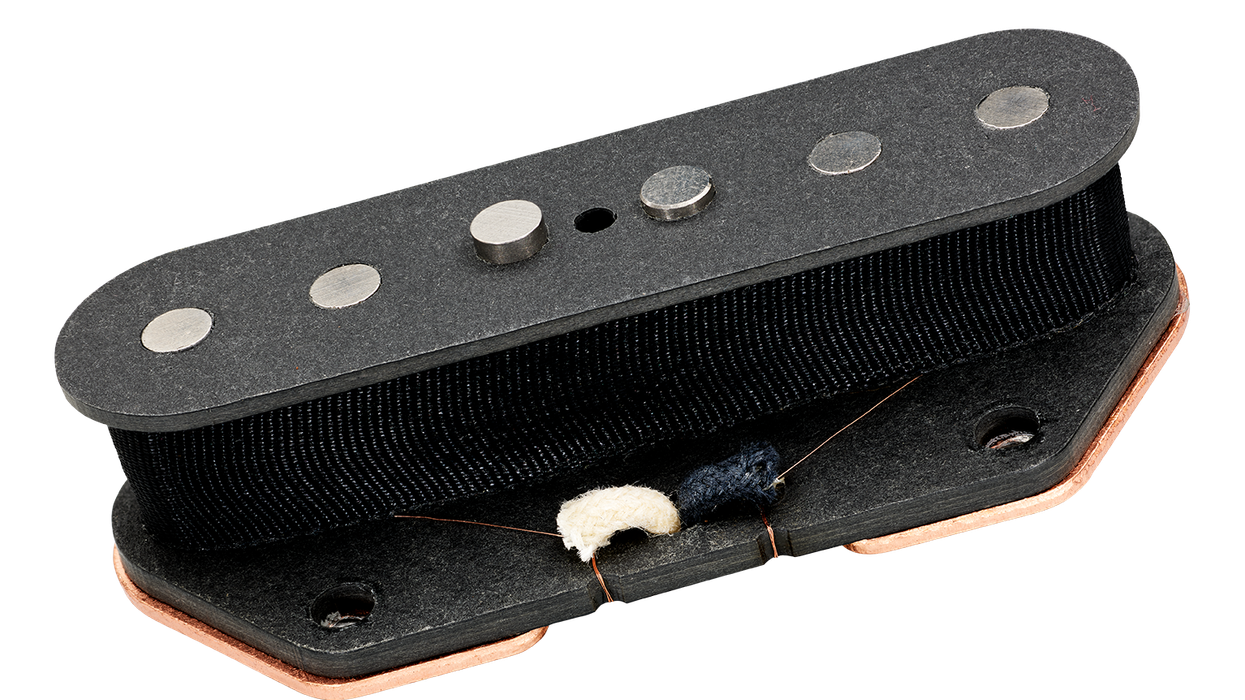
Adding to the company’s broad ranging product line, DiMarzio has introduced three new models this summer: a pair of brand new pickups for beefing up your Tele-style guitar, and a new configuration of the legendary Super Distortion humbucker.
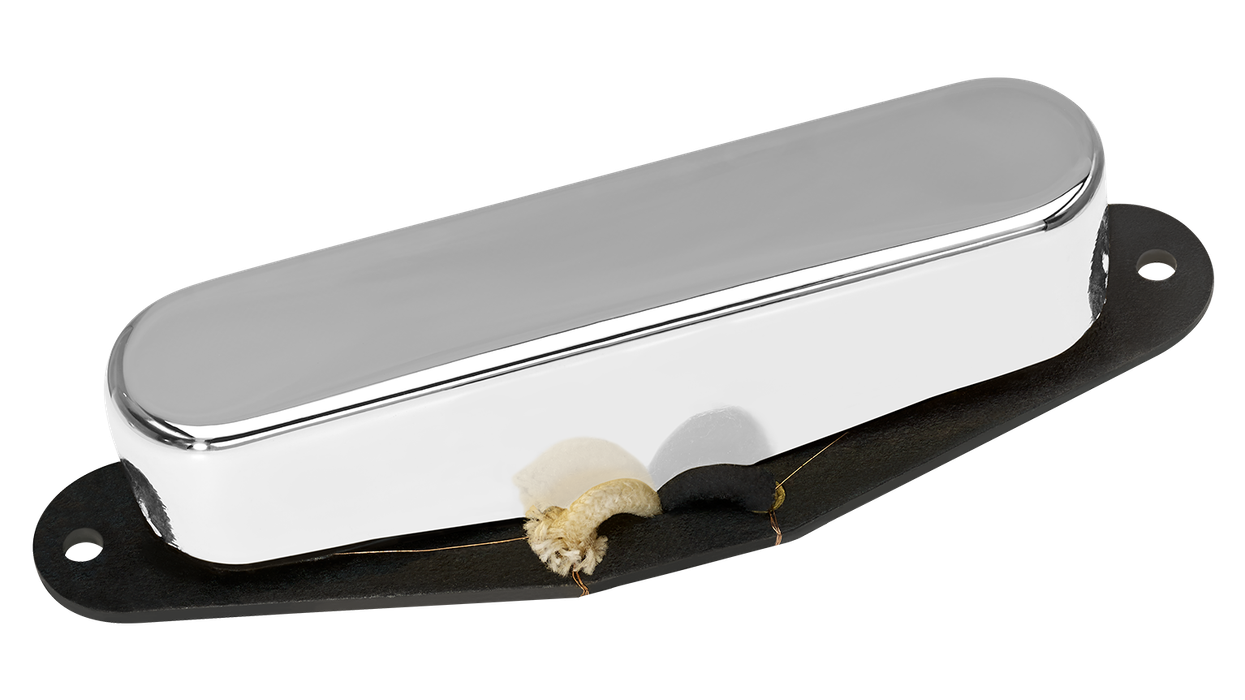
The DP436 Muscle T Neck retains all the dynamic response of a good early sixties Tele® pickup but adds more of the glassy sparkle that guitarists crave. The Muscle T™ Neck has been carefully calibrated with extra volume and presence to keep up with the needs of today’s players, and the overall musical character delivers a better string-to-string balance for rhythms that cut and precise soloing.
Both models are drop-in replacements for standard Telecaster pickups and offer traditional 2-conductor wiring.
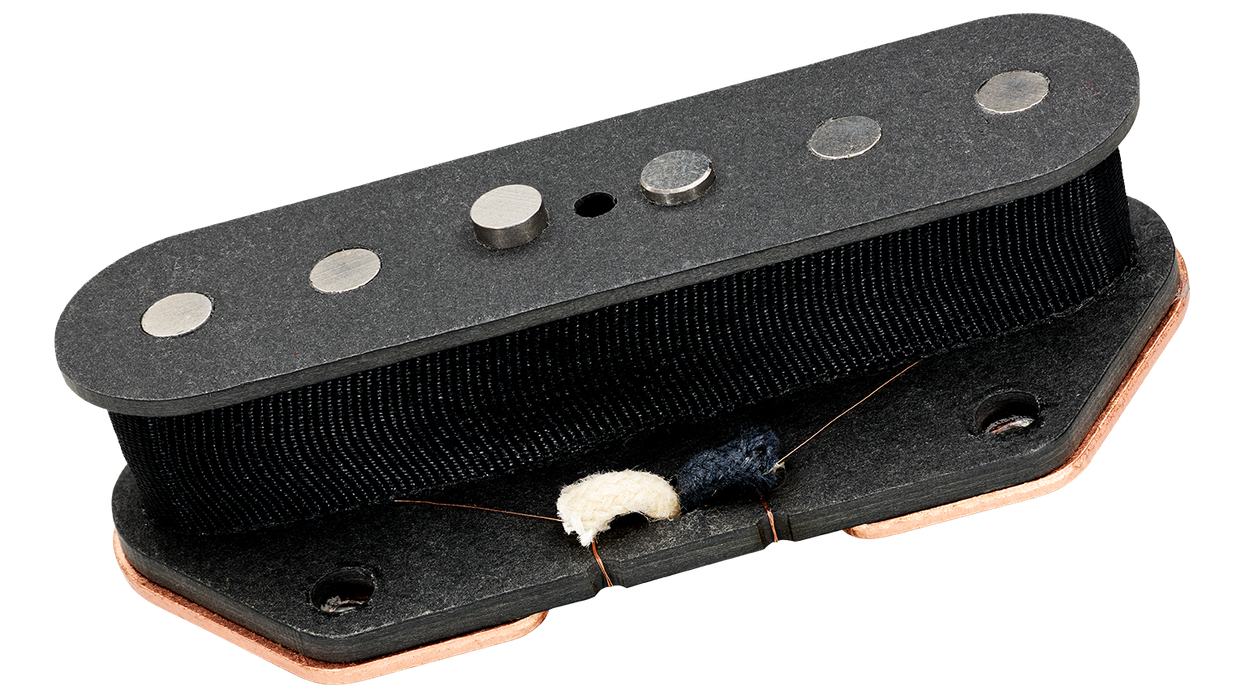
The DP437 Muscle T™ Bridge and DP436 Muscle T™ Neck pickups capture the best attributes of classic 1960s vintage Telecaster pickups with a dash of added output.
The DP437 Muscle T Bridge utilizes a traditional magnet stagger inspired by early ‘60s Tele® pickups, but DiMarzio has kicked the output up a notch to get more sustain and added warmth to the top end to eliminate the harshness. The balanced lows, mid-range snarl and clear top end make the Muscle T™ perfect for any player that wants legendary single coil Tele® tone with a modern touch.
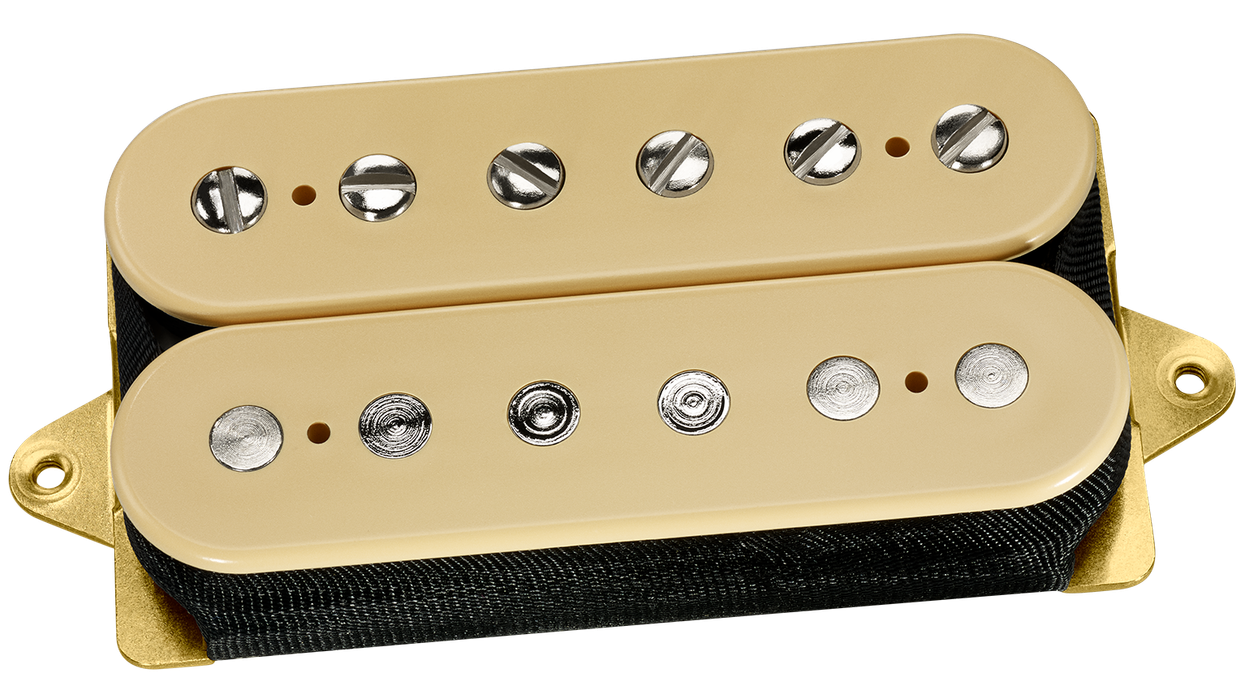
DiMarzio’s DP500CR Super PAF® Ceramic is a new version of the legendary pickup that put high-output ceramic humbuckers on the map, now available with a vintage PAF® look.
The original Super Distortion® started a sound revolution. Replacement pickups simply didn’t exist before the invention of the Super Distortion® in the early Seventies. The Super Distortion® (and its original 3-conductor version, the Dual Sound®) was the first pickup specifically designed to kick a tube amp into total overdrive, brandishing a perfect blend of power and tone: both single-notes and chords jump out of the amp and fill the room (or the track) with a wall of sound.
DiMarzio’s DP500CR Super PAF® Ceramic delivers the classic sound you’ve heard for five decades on platinum records from players as varied as Ace Frehley, Al Di Meola, Phil Collen, Tom Scholz, and Paul Gilbert. It’s also versatile: 4-conductor wiring allows instant access to Strat®-like split and series-parallel modes.
Street pricing for the DP437 Muscle T™ Bridge and DP436 Muscle T™ Neck is $89 each. The DP500CR Super PAF® Ceramic carries a $99 street price. Each pickup is individually hand-wound and tested in DiMarzio’s New York City factory. For more information visit dimarzio.com.
MXR Bass Synth Review
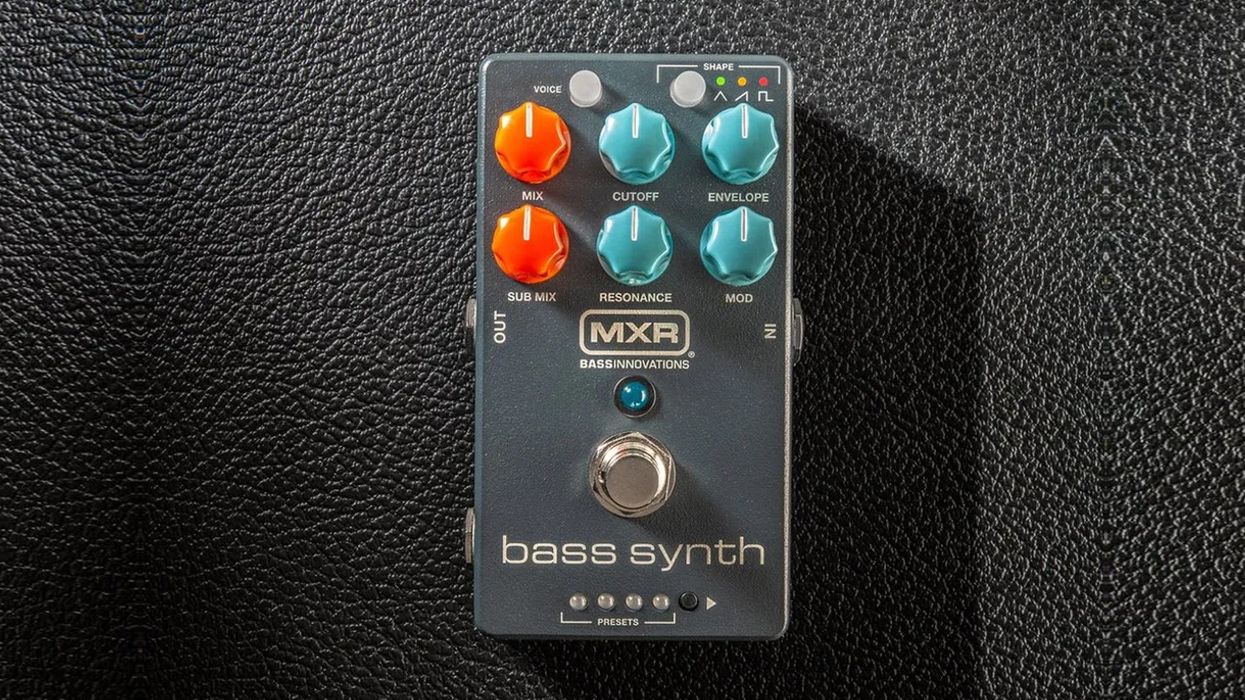
Synth-bass pedals have been around for a long time. They’ve come in a wide variety of flavors and achieved various degrees of success as far as tones and designs go. But, in my experience, they are a class of pedals that are tough to get right. Tracking and latency are always challenges. And they don’t always do a great job of approximating vintage synth-bass patches from classic recordings—specializing in sounds better suited for a sci-fi movie or avant/experimental projects than a Stevie Wonder or Michael Jackson context. MXR’s new Bass Synth, however, delivers where so many other bass synths fall short.
Source Material
In developing the Bass Synth, MXR called on Ian Martin Allison for an artist’s perspective. Allison is a Minneapolis-based bass player with a prominent session resume, a regular on the very popular Scott’s Bass Lessons, and maintains a steady gig with singer-songwriter Eric Hutchinson. He also maintains his own strong online following by creating and sharing synth-bass-style tones made with traditional pedal combinations and his programmable multi-effects unit. Allison’s faithful reproductions of classic synth sounds created with electric bass made him the ideal sounding board for the MXR team.
Can’t Judge a Book by Looking at the Cover
At a glance, the MXR Bass Synth looks pretty conventional. There are just six rotary controls and a few buttons. But looks, in this case, are deceiving. The MXR is feature-packed, and I couldn’t possibly cover all of them here. But the in-depth, 30-minute video instruction manual Jim Dunlop put up on YouTube hints at the expansiveness of its potential.
For the convenience-minded player—or synth beginner—the heart, soul, and saving grace of this pedal might be the presets. Many bass players have limited experience with the process of real creative synthesis via waveforms and filters, and MXR’s factory presets help fast-track the leap to bass-synth sound design. There are many useful departure points and they make the pedal instantly usable. Allison had a hand in developing the presets, and most are easy to incorporate into your playing style. They include sounds inspired by Michael Jackson’s “Thriller,” Stevie Wonder’s TONTO synth, the Minimoog sound on Funkadelic’s “Flashlight,” as well as modern patches inspired by specific songs and artists as diverse as Björk, Nine Inch Nails, and Deadmau5—and that’s a short list of what’s here. There are user-programmable presets, too, of course, and expression-pedal compatibility enables filter sweeping and other effects.
Like an Old, Funky Friend
The first thing I did when I plugged the Bass Synth in was engage the preset for “Thriller.” I tweaked the sub-mix control ever so slightly to add a little more bottom to the sound and was knocked out by the accuracy of the tracking. Even when I added lots of vibrato and dramatic slides—moves that would confound a lesser bass synth—the sound was punchy and clear, and with a tweak of the mix control I could let just a tiny amount of the original tone of my bass in to lend extra clarity. Best of all, though, I did not have to alter my playing to make these sounds work. The Bass Synth is both familiar and forgiving.
To get a handle on the breadth of the possible synth textures, check out the sound clip for the edgy “Flashlight” Minimoog-style patch (clip 2). This patch is an assault on the senses—intense, aggressive and conducive to overflowing sustain. This patch takes up space in the best way and makes me play much more economically, which is always a wonderful feeling. I was most excited about the “moneymaker” patch, though, which takes a cue from the Herbie Hancock classic, “Chameleon.” With its quick filter sweep and short, funky attack, it lends itself beautifully to staccato-style playing, and mixed in with a bit of my bass’ original sound, it’s a great alternative to an envelope filter.
The Verdict
Gamechanger. It’s an overused word, but MXR earns the title here. This unit gets us closer than ever to not needing to bring a keyboard to the gig. It is usable right out of the box yet contains endless opportunities for deep dives and creativity way beyond what the relative simplicity of the pedal suggests. Whether you have no experience with synth bass or you are a daily key bass player, you should get this pedal. The Bass Synth might not be for every bassist, but if you’re expected to cover a lot of tonal ground or are just a restless bass explorer, it is potentially a staple with a strong chance of staying on your board forever.
Ozzy Osbourne, Godfather of Heavy Metal, Dies at 76

Ozzy Osbourne, the iconic solo artist and singer for heavy metal pioneers Black Sabbath, has died at age 76. His family confirmed his passing in a statement on Tuesday, July 22.
“It is with more sadness than mere words can convey that we have to report that our beloved Ozzy Osbourne has passed away this morning,” the statement began. “He was with his family and surrounded by love. We ask everyone to respect our family privacy at this time.”
Born John Michael Osbourne in Marston Green, England, in 1948, Ozzy was inspired to become a musician after hearing the Beatles’ hit “She Loves You.” He linked up with guitarist Tony Iommi, drummer Bill Ward, and bassist Geezer Butler around 1968, and by August 1969, they’d renamed their band Black Sabbath, after the 1963 film of the same moniker.
With Osbourne’s mournful, weighted howl at the helm, Black Sabbath released some of heavy metal formative and most influential recordings. Their first two LPs, Black Sabbath and Paranoid, minted monumental rock-canon staples like “N.I.B.,” “The Wizard,” “Paranoid,” “War Pigs,” and “Iron Man.”
For their time, Black Sabbath’s sound and lyrics were disturbingly dark and heavy. Both fans and critics could agree on one thing: their music was “wicked,” each in their own sense of the word. It’s no surprise, then, that soon after Sabbath began releasing records, Osbourne and the band became frequent targets of religious groups accusing them of promoting Satanism and radiating “evil” energy. For their followers, that was exactly the appeal. Long before “horror rock” was a genre, Ozzy and Sabbath made music that shocked and unsettled listeners, confronting the cruelty, madness, and injustice of modern life.
“Throughout his career, Osbourne surrounded himself with celebrated, genre-defining guitarists.”
Throughout his career, Osbourne surrounded himself with celebrated, genre-defining guitarists, starting with Tony Iommi, whose crushing, downtuned Gibson SG-powered riffs not only defined Black Sabbath’s music, but helped to forge the sound of heavy metal itself. After Ozzy was fired from Sabbath, he teamed up with guitarist Randy Rhoads and launched his solo career with 1980’s landmark Blizzard of Ozz. The album catapulted Rhoads to international fame as a bona fide guitar hero. He could deliver towering, electrifying riffs and solos on tracks like “Crazy Train” and “Mr. Crowley,” but he also brought a classical and more emotional sensibility to Ozzy’s music, evident in the acoustic melancholy of “Dee” and the dramatic, environmental-apocalypse themes of “Revelation (Mother Earth).”
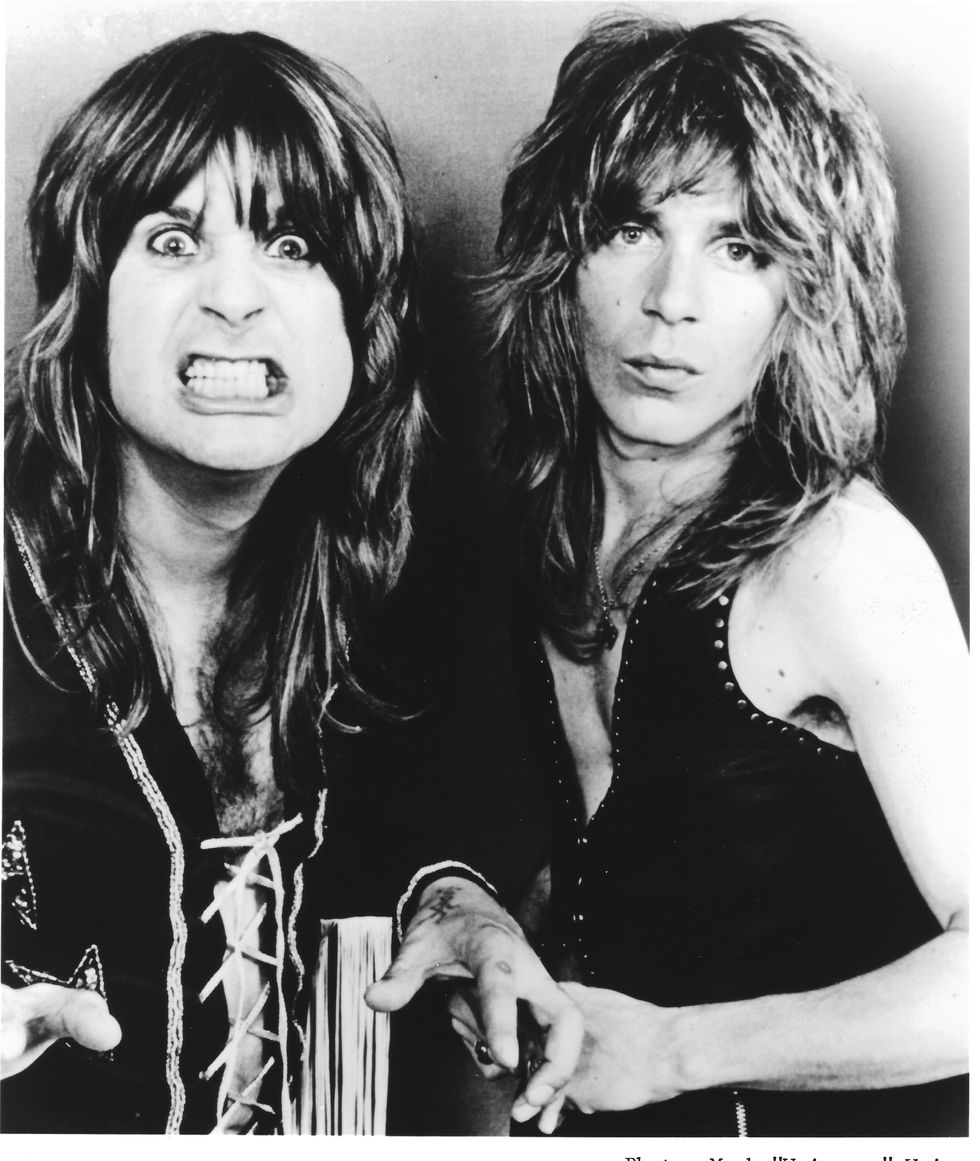
Diary of a Madman, their second album together, further established Osbourne’s solo career and cemented Rhoads, with his Karl Sandoval-built polka dot Flying V and Jackson V-style electrics (as well as the occasional Les Paul), as a guitar icon. Tragically, Rhoads died in a plane crash in 1982, and Osbourne eventually tapped the shredder Jake E. Lee as his permanent replacement. That partnership lasted for two more successful albums, Bark at the Moon and The Ultimate Sin, but it was in 1987 that Osbourne found his most longstanding guitar foil—20-year-old Jeffrey Phillip Wielandt, better known as Zakk Wylde, who auditioned to replace the recently departed Lee. Wylde’s shrieking pinch harmonics, scorching wah-pedal leads, and chorus-colored chording defined a new era of Osbourne’s musical life on songs like “No More Tears,” “Miracle Man,” and “Mama, I’m Coming Home.” Osbourne continued to collaborate with Wylde through the 2000s, and Wylde performed at Osbourne’s 2024 Rock and Roll Hall of Fame induction ceremony.
As he moved through his career, Osbourne was infamous as much for his music as for his wild antics—such as the never-to-be-forgotten bat- and dove-biting incidents. Though he achieved sobriety at various points in his life, his oft-imitated slurred vocal delivery and hell-raiser image remained his calling cards.
Osbourne had been battling a Parkinson’s disease variant, amongst other ailments, since at least 2020, which hindered his ability to perform onstage. At Black Sabbath’s final show, an all-day affair that took place on July 5 in their hometown of Birmingham, England, Osbourne sang from a chair topped with a black bat—an homage to his old foe, perhaps. Osbourne appeared visibly frail; nevertheless, it was a triumphant performance, as he powered through a short set of solo classics before reuniting with his old bandmates for four songs.
Osbourne’s “Prince of Darkness” moniker was often tied to the occult and sinister themes in his music, but he knew real darkness from an early age. He struggled with dyslexia in school, was sexually abused at age 11, and attempted suicide multiple times as a teenager. At 17, he spent six weeks in prison after robbing a clothing store. He did not arrive at darkness by choice; it was thrust upon him.
Over 50 years, Osbourne created music that faced down, rather than ignored, the bleak, lonesome truths of the human experience. Thanks to him, and the fleet of ace guitarists he worked with, generations have learned to embrace and probe the shadows lurking behind the light, and to make sense of them through ferocious guitar riffs and monstrous rock songs. Those are skills we’ll likely always need.
YouTube
Ozzy Osbourne performs “I Don’t Know,” the leadoff track from Blizzard of Ozz, with Randy Rhoads, bassist Rudy Sarzo and drummer Tommy Aldridge, in 1981.
Fender Custom Shop Pays Homage to Ariel Posen with Signature Stratocaster
Today, Fender Musical Instruments Corporation (FMIC) and the Fender Custom Shop (FCS) are proud to introduce the Limited Edition Ariel Posen Stratocaster®, an instrument with enough versatility and raw playing power to properly honor the virtuosic guitarist, songwriter, producer and vocalist. Posen’s playing is unique not just in its sheer technical proficiency and musicality, but in the way it spans a number of genres ranging from old delta blues to neo soul to good old fashion rock and roll. With this in mind, the Fender Custom Shop understood that Posen’s signature instrument had to come ready to tackle just about any sonic assignment under the sun. Thanks to a set of custom AP-90 pickups, designed in tandem with Tim Shaw, and simple but powerful controls, the Limited Edition Ariel Posen Stratocaster® can handle scorching hot solos and sultry chord work in equal measure.
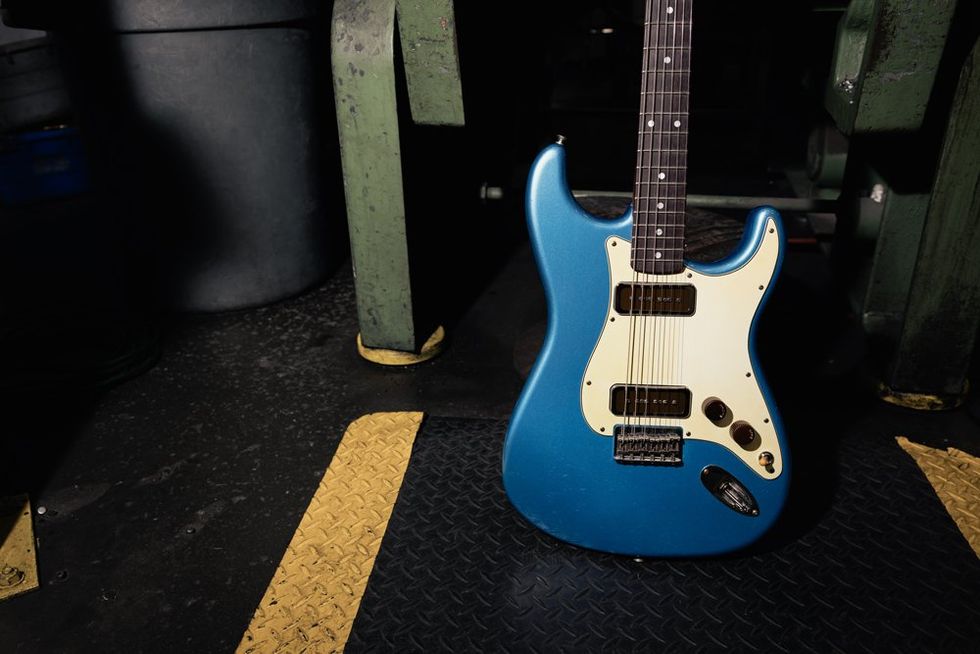
“This is the most genuine and authentic representation of what I’m looking for in a guitar,” said Ariel Posen. “I was always a Strat ® guy and always felt most comfortable playing them, so it was important to capture those qualities. But the AP90 pickups really highlight my love for Jazzmasters—there’s something so open and airy about those guitars. More than anything, this Strat® embodies everything I love about Fender and condenses it into one instrument.”
Ariel Posen first arrived at the guitar after spending years on the road with his two parents, both touring musicians, and developing the musical itch for himself. While he began his journey on the piano, an adolescent love for ‘90s grunge and The Beatles found him swapping out the keys for a Strat®. Today, whether he is captivating packed venues across the world, on his upcoming U.S. Tour this fall, or regaling his social audience, Posen has carved out a place for himself among the heroes of modern day guitar playing.
From the Journeyman Relic® Faded Lake Placid Blue finish to the quarter sawn AA flame maple neck, the Limited Edition Ariel Posen Stratocaster® oozes with road worn charm. But don’t let this guitar’s vintage appeal fool you, it is outfitted with new, custom electronics that are versatile and powerful. A pair of pickups were custom made with Fender’s legendary pickup designer, Tim Shaw, to capture the full spectrum of Posen’s sonic vocabulary—from swampy, growling leads to glassy clean tones and everything in between, these pickups deliver perfect harmonic clarity across all playing styles. In tandem with the vintage-style hardtail Stratocaster® bridge and roasted alder body, it’s nearly impossible for this guitar to deliver anything short of full-bodied, resonant perfection.
LIMITED EDITION ARIEL POSEN STRATOCASTER® ($6,000.00 USD, £5,699 GBP, €6,799 EUR, $9,499.00 AUD, ¥1,045,000 JPY) From scorching, octave fuzz-soaked slide solos to beautifully crafted chord changes and soulful grooves, Ariel Posen’s guitar playing is unmistakable. As a self-proclaimed “Strat® guy,” Posen teamed up with the Fender Custom Shop to introduce the Limited Edition Ariel Posen Stratocaster®, creating the most authentic representation of what he’s looking for in a guitar. Drawing influences from both traditional Fender specs and more unconventional features, this Strat® can deliver anything from flowing, bell-like chime to gnarly, punchy tones.
The Faded Lake Placid Blue Relic® lacquer-finished 2-piece select roasted alder body, quartersawn AA flame maple neck and round-laminated rosewood fingerboard give this guitar the look and feel of a well-loved mid-‘60s instrument, while the dueling AP-90 pickups, simplified controls and cupcake knobs are distinctly representative of Ariel’s playing style and taste. The custom pickups were designed in tandem with Fender’s legendary pickup designer, Tim Shaw, to capture both the nuanced warmth and clarity of a vintage Jazzmaster® neck pickup and the powerful midrange bite of classic soapbar bridge pickups. When combined with vintage-style hardtail Stratocaster® bridge and roasted alder, these pickups enhance even the most gentle, subtle playing with full-bodied resonance and sustain.
Other premium features include 1969 “U” back-shape, 9.5” (241 mm) radius, 21 vintage upgrade (45085) frets, mother of pearl dot inlays, custom Caballo Férreo (master volume, master tone) wiring, 3-way switch, 3-ply parchment pickguard, vintage-style tuning machines bone nut, American Vintage ‘59-’64 string tree, deluxe hardshell case, Moody Leather Ariel Posen signature strap, The Rock Slide Ariel Posen signature brass slide, Dunlop Ariel Posen picks and certificate of authenticity.
Modern Classics On Tap: Sub-50 Watts from Suhr, PRS, and Blackstar
Looking for versatility without cranking a stadium-level rig?
In this video, PG contributor Tom Butwin puts three sub‑50-watt amplifiers to the test: the British‑voiced Suhr SL15, the mid‑’60s American‑style PRS Sonzera 20, and the gig‑ready solid‑state Blackstar Debut 50R. Tom explores the tones, features, and ideal use cases of all three amps—highlighting who they're best suited for and how they perform in different setups. Which one fits your playing style and needs?
Suhr SL15 15-watt Tube Amplifier Head - Black Tolex/Gold Faceplate
SL15 15W Tube Head
PRS Sonzera 20 20-watt 1 x 12-inch Tube Combo Amp
Demo Sonzera 20W 1x12 Tube Combo
Blackstar Debut 50 50W Guitar Combo Amp Black
The Blackstar Debut 50R 50W Guitar Combo Amp
Sweetwater Announces Return of GuitarFest on September 27

Sweetwater has announced the return of GuitarFest,which is coming to the company’s Fort Wayne campus on Saturday, September 27. The nation’snumber one online retailer for music makers will welcome guitar players and music fans toexplore manufacturer booths from some of the top guitar name brands such as Gibson, Fender,and Marshall. There will also be appearances by major artists throughout the day.
Now in its second year, Sweetwater’s GuitarFest promises a packed schedule designed to excite guitar enthusiasts and music lovers alike. Attendees will have the opportunity to hang out and connect with their favorite brands and some of their favorite artists.
“We’re thrilled to bring GuitarFest back for its second year,” commented Samantha Hunter, director of artist relations and campus events at Sweetwater. “We’ve taken everything we learned from last year’s event — along with the valuable feedback from attendees — and used it to make the experience this year even better. We truly believe 2025’s GuitarFest will be an unforgettable celebration for music lovers of all kinds.”
Sweetwater will showcase the latest guitar and related gear releases along with vendors on-site to answer and demonstrate the very latest guitar innovations. GuitarFest also marks the culmination of eight days of in-store deals as part of Guitar Month at Sweetwater.
Artist appearances will be announced in the coming weeks. Early registration for this free event is available now at Sweetwater.com/guitarfest/ where visitors can also stay up–to date on all the planned activities.
This event is family friendly and takes place on Sweetwater’s state-of-the-art campus located at 5501 US Highway 30 West in Fort Wayne. The Sweetwater campus includes the largest music store in the United States and other attractions for visitors to enjoy.
NC-4 Frank Bello – A bold New Design from Two of New York’s Biggest Bass Icons
Frank Bello, best known as the bassist of New York’s legendary thrash metal pioneers Anthrax, has joined forces with Spector Bass to develop an all-new instrument. Dubbed the NC-4 Frank Bello, this bass is inspired by both Spector’s rich history and iconic American bolt-on bass design.

From its refined body contours and radiused top to the uniquely contoured neck heel, the NC-4 is built for speed, comfort, and stage-ready performance. Finished in a head-turning metallic purple affectionately named Tina Rose after Bello’s mother and grandmother and features a matching headstock, purple acrylic block inlays, and Bello’s signature EMG P/J pickup set.
Furthermore, the NC-4 features a solid Alder body, a 1-piece Maple neck, and a Maple fingerboard – a tonewood trio that delivers the perfect blend of warmth, brightness, and clarity. The neck profile, modeled after Bello’s favorite vintage instruments, offers a slim, broken-in feel that’s instantly familiar.
Finished with vintage-style chrome tuners, a modern adjustable bridge, and a brass nut for enhanced sustain, the NC-4 Frank Bello is ready to take on the world’s biggest stages – just like its namesake.
“Spector is known for quality. My signature bass is built for players and offers incredible tone, comfort, and affordability. From the neck profile to the woods, signature EMG pickups, and brass nut, this is my ultimate go-to for any gig, Anthrax or other.” – Frank Bello
The NC-4 Frank Bello is more than a signature model – it’s a statement. Available now at authorized Spector dealers worldwide.
$1499.99 US Street Price
Meris Enzo X Review
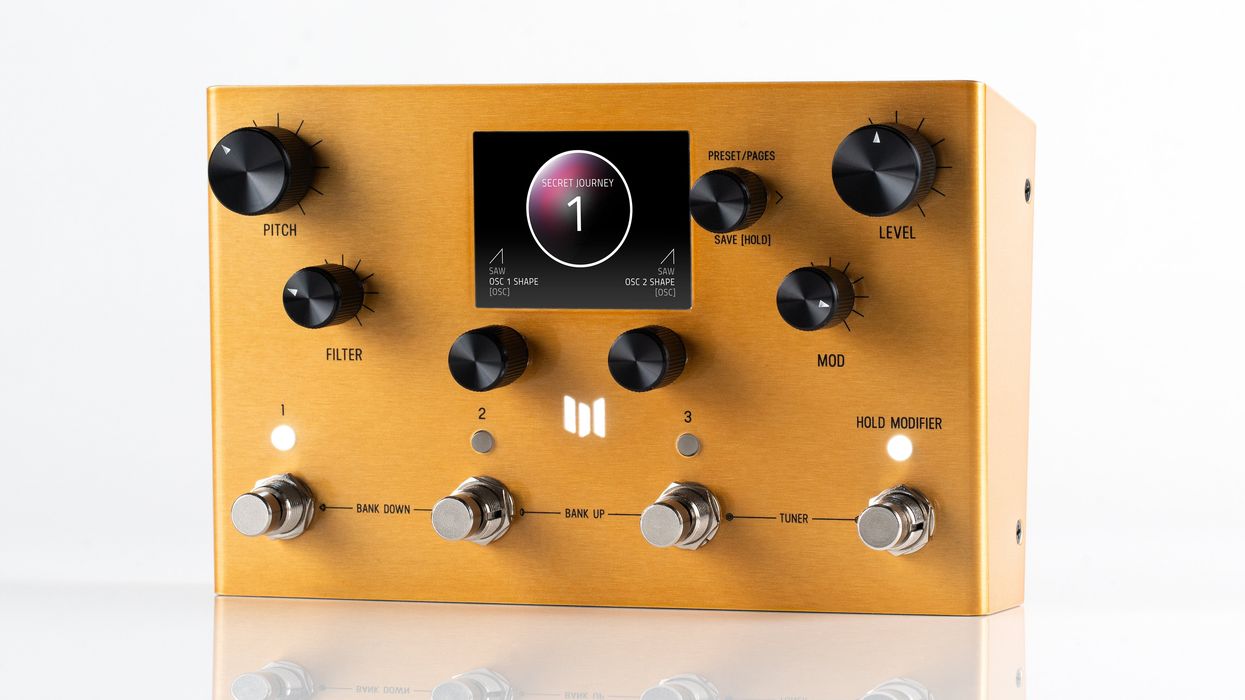
For many of us, an electric guitar is as much a sound-design tool as a melodic vehicle. On the days and weeks when I can’t seem to coax a song or hook from my guitar, I love the release of just making noise, loops, and atmospheres that can bring me back around to the guitar as a conduit for melody. Meris’ Enzo X—which, on many nights, left me rapt in one of these less-self-conscious states—is more than a noise machine. Much more. In fact, it’s a very capable instrument in its own right: a polyphonic input synthesizer that also happens to work brilliantly with guitar and bass. And whether you’re looking for an elusive song’s magic side door or scoring a movie, Enzo X can crack open new states of guitar consciousness.
First, though, a word for those inclined to dive into a pedal like this recklessly: Figuring out how to save and recall presets is essential. Like any interactive synth stacked with many possible tone and mood departure points. It’s easy to get lost, forget where you came from, or lose track of the sonic gold you find in your meanderings. And there is indeed gold to uncover here.
Scare Tactics
Many of the sounds you can trigger with your guitar (or any instrument, for that matter) will be recognizable as cousins to classic analog synths. Working from factory presets, I found voices evocative of Minimoogs and ARPs as well as triggers for cool sequencing and arpeggiating effects. A player’s inner John Carpenter can run wild among these voices. (Try preset 52, “poly 77 artic” for a start.) And as I absentmindedly re-tracked The Thing in my head, I ended up really pleased—and creeped out—with the sounds I found in the chase.
More relatable guitar-oriented effects are here as well. There are many odd but operationally accessible phasers and envelope effects, to name a few. But the big fun is in probing the synth’s voices and working through how your playing adapts to each voice’s performance envelope. Many, for instance, rely on pitch or envelope triggering, which, at times, effectively deconstructs the fretboard and your sense of touch dynamics. Sometimes that yields frustration. But if you’re receptive to what the Enzo X gives back, you can open up pathways that reshape your sense of phrasing and timing and push back at your most obvious tendencies.
The Verdict
The Enzo X isn’t exactly easy to operate, but it isn’t unintuitive, either. The interface and menu design are inventive, functional, and, after some practice, pretty fluid. By the time I found my own creative orientation toward the pedal’s many powerful sounds, I’d achieved a fast-paced rhythm for working within the controls. At $599, the Enzo X is an investment. And it probably won’t be an automatic fit for most guitarists that are song-oriented in the most formal, familiar sense. But for the right player, the Enzo X could easily yield more musical return than another electric guitar or several pedals at the same price
Laser-Engraved Paisley Transforms a Classically Configured T-Style
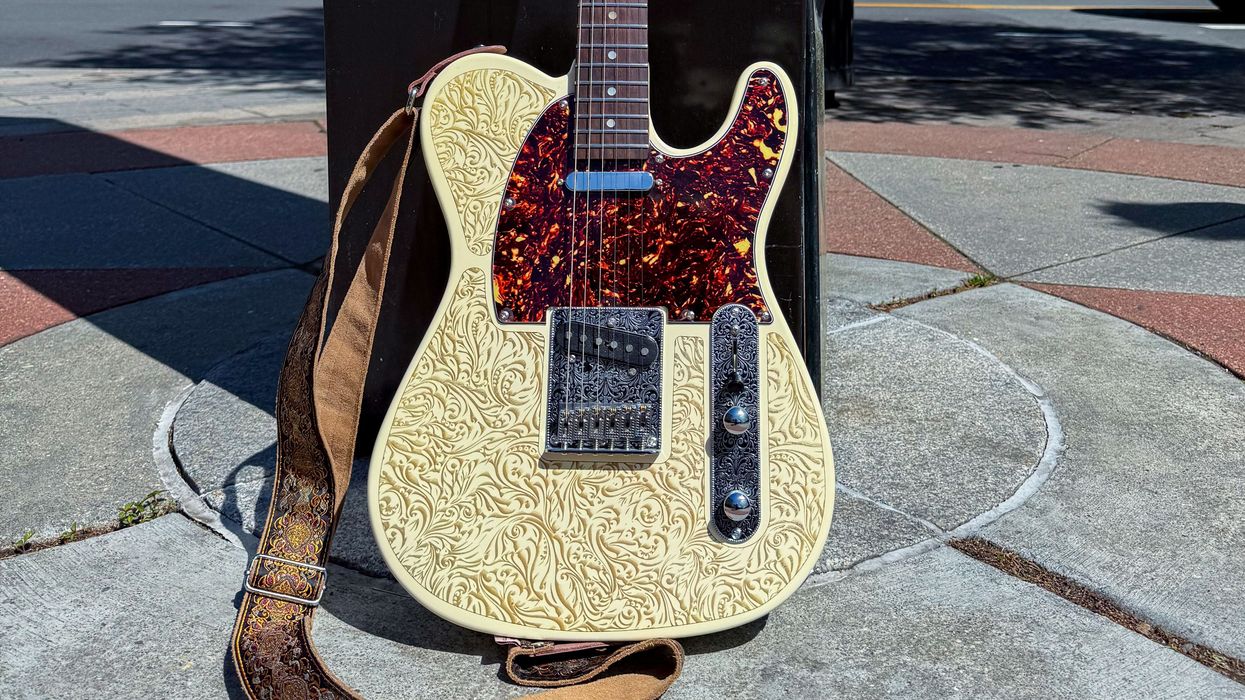
Fancy filigree distinguishes a reader’s ideal manifestation of straight-ahead Telecaster essence.
Reader: Charlie KramerHometown: Arlington, VirginiaGuitar: CAM Custom Guitars T-Style
I’ve wanted a great Telecaster forever. I bought my first one back in the 1990s and I’ve owned five or six T-styles since, including Fenders, Squiers, G&Ls, and various knockoffs. None of them had everything I was looking for: twang with body, great playability, big frets, and a just-beefy-enough neck—something that could switch between rock and country like a boss. I’m picky; I’ve played guitar since the ’70s—gigging and recording actively—and, in that time, owned a couple dozen guitars from off-the-rack instruments to vintage Fenders and Gibsons, pawnshop weirdos, and some custom made ones, too. But if a guitar doesn’t speak to me, it gathers dust and then goes on Reverb.
A while back, my friend Chris Moreau at CAM Custom Guitars was cooking up something special. Chris made a couple guitars for Tracii Guns of L.A. Guns, so he knows his stuff. He also made a superb Flying V-style that my wife gave me as a Father’s Day gift a few years back.
Chris put together this T-style with an alder body, a roasted maple neck with Jescar stainless-steel frets sourced from Havok Guitars, Fender Pure Vintage ’64 Telecaster pickups, and an engraved Wanby bridge and control plate. Then, Greg Wells at DoubleU Design Studio in Falls Church, VA, burned an amazing paisley design into the top with a Glowforge laser engraver.
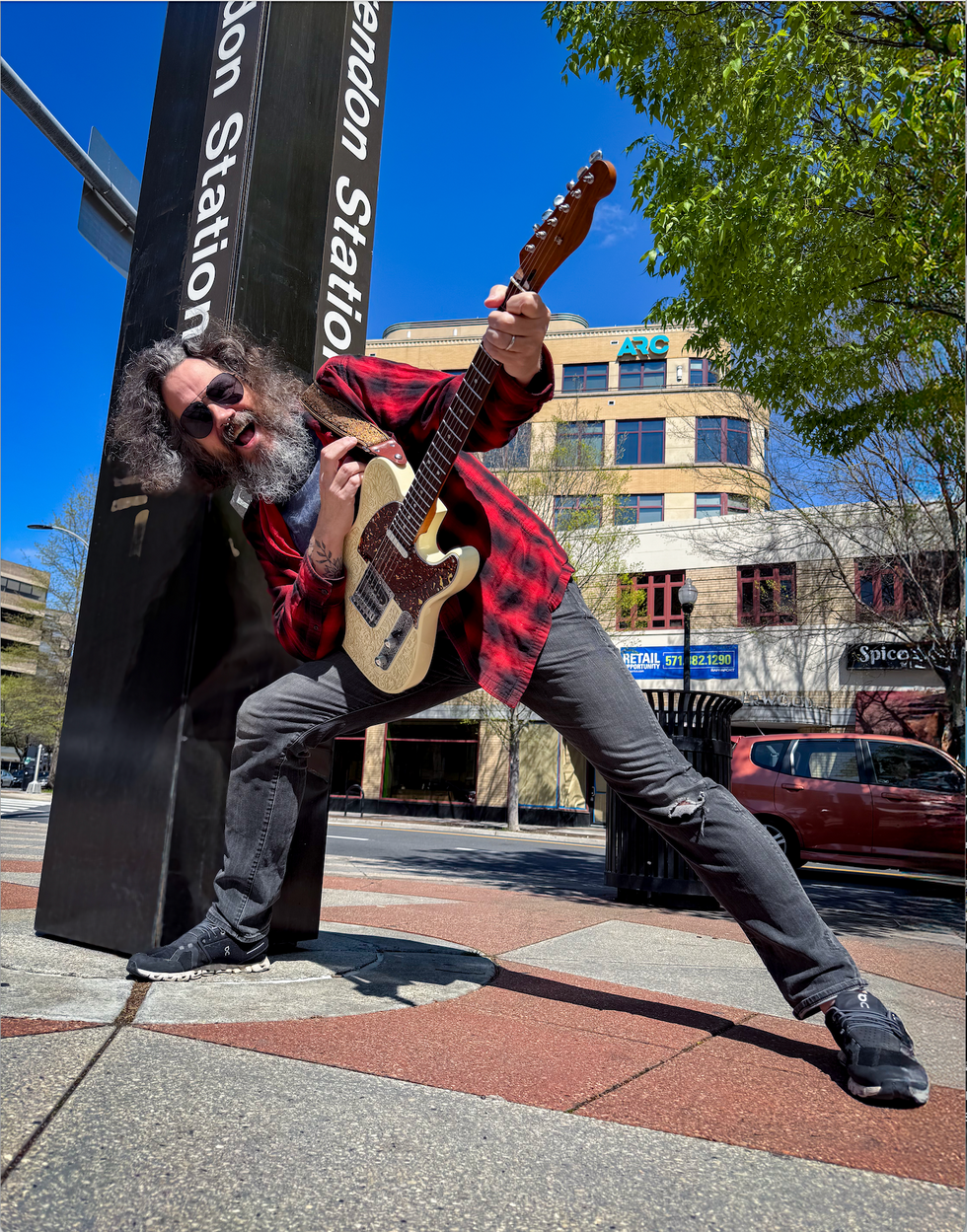
“When plugged into a cranked amp, it could move from Waylon Jennings to Jimmy Page by just adjusting the volume and tone knobs.”
I watched with envy when Chris listed it for sale, and I had to play it before he sold it! But as soon as I had it in my hands, I had to have it. It rang like a piano, and when plugged into a cranked amp, it could move from Waylon Jennings to Jimmy Page by just adjusting the volume and tone knobs. The big stainless frets made bends smooth and easy. I wrote him a check and got out of there with my new prize.
Since then, it’s been one of my main gigging and recording guitars. I used it on a demo for my band Mother of States and played it onstage with the Vaping Nuns (a band I play in with Chris and Greg). When I’m taking a break from work or want to run scales, it’s my go-to instrument—always just a few feet from my desk. Finally, I have the T-style of my dreams!
Nobody Can Keep Up with Buddy Guy | 100 Guitarists Podcast
Buddy Guy’s high-energy, crowd-strolling performances set the bar for every electric blues and blues rock guitarist who came after him. And that includes Jimi Hendrix.
Buddy changed the game and left an indelible mark on the sound of electric guitar playing. He’s still out there, delivering incendiary performances to stages all over. On this episode, we’re talking about one of the last blues guitar showmen, whose polka dot signature Strat caught both of our eyes. Where’s the best place to start? And where did Buddy get all that energy?
Thanks to our Sponsor, Xvive!
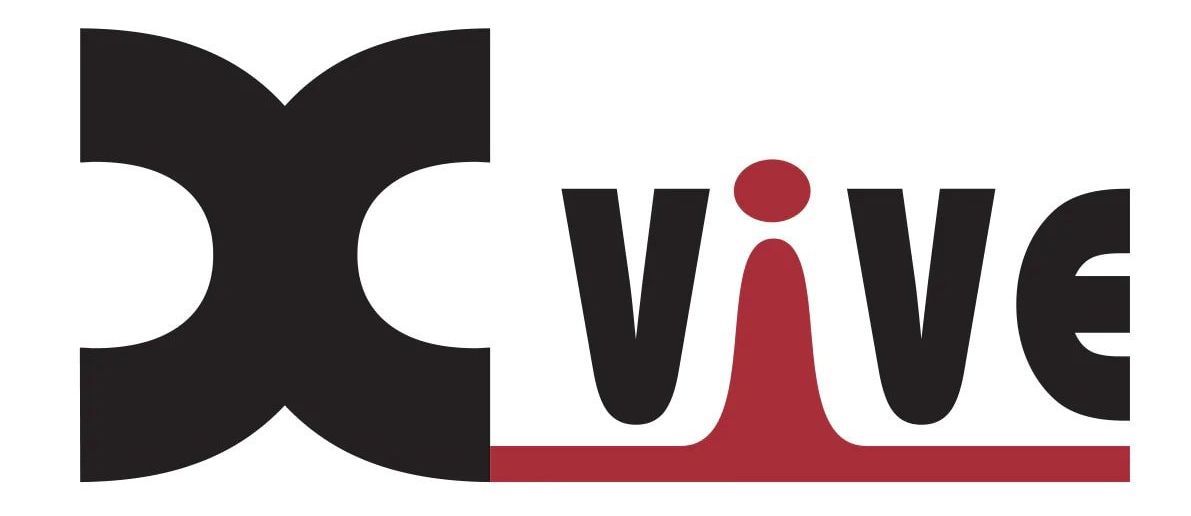
LEARN MORE! https://xvive.com/
Suspended Truths

Suspended chords have a unique sound and play an important role in a variety of styles of music. A quick internet search will give you the basic theory, but few articles help you actually apply these ambiguous sounds. You see, these chords are neither major nor minor, so where do they fit in? Let’s find out.
What Is a Sus Chord?
Suspended chords are notated in shorthand with “sus,” and there are two types: a sus4, and a sus2. If you see a chord symbol that just says “Csus,” the implication is that the chord is a sus4. Starting with a basic C major triad (C–E–G) we simply move the 3 up a half step to the 4 of the scale (in this case, F). You end up with C–F–G, which is shown in Ex. 1. A word to the wise: Break down your major chord shapes and locate the 3. That is the note you need to move up one fret to turn it into a sus4 shape.

Suspended chords are typically the dominant chord in a key, also called the V chord. A Vsus4 chord creates musical tension and a sense of ambiguity. It will typically resolve back to the V chord and then resolve to the I chord. Look at Ex. 2 to see how this tension-release resolution sounds, and how it works on the guitar.

Dominant 7 chords can also be suspended as well. The process is the same, so your dominant 7 chord goes from 1–3–5–b7 to a 7sus4, which is spelled 1–4–5–b7. Ex. 3 shows some common C7sus4 to C7 voicings. You can find these dominant 7 suspended sounds in multiple styles and sub-styles of jazz, funk, and disco. Take a look at Ex. 4 to see some three-note voicings that are found in those styles.


Let’s continue with the C7sus4 sound, building it in a couple of different ways. The first is what is called a “polychord” (or sometimes a “change-bass” chord). If you play a Bb major triad over a C bass note, you have effectively built a chord that functions as C7sus4. It could be labeled as Bb/C and spelled C–Bb–D–F. This voicing is a very common sub for a traditional 7sus4 chord and has three of the four notes needed to create that sound. There’s no 5, but that’s ok. The 5 is a throwaway note when it’s not altered. The second way is to play a voicing that keeps the 3 and 4 but still sacrifices the 5, providing some interesting musical tension. Each of these voicings are seen in Ex. 5.

So, how do you play over a suspended chord?
Since a suspended chord functions as the V chord in a key, you would use the Mixolydian mode to play over that sound. Be careful to stay away from really bluesy guitar licks or running up and down the scale. Stick to sequences, patterns, or other structures, and listen to Ex. 6 for some possibilities.
The next couple of approaches use the Bb/C chord structure as inspiration. Remember that C7sus4 is the V chord in the key of F, and Bb is the IV chord in that key. Use that pair of triads to create your melodies since you have Bb–D–F and C–E–G at your disposal. If you line those notes up as a scale, you get C–D–E–F–G–Bb, which is just one note shy of the C Mixolydian mode. The difference is that you are organizing the notes in triads as opposed to a scale. Take a listen to Ex. 7 as one possibility on how to break up the triads while creating a solo.
Next, focus your solo on just the sound of the IV chord, or Bbmaj7. Experiment with limiting yourself to just the notes of the chord, Bb–D–F–A, and hear how they sound like the b7, 9, 11, and 13 of C7sus4. You can also loosen it up a bit, emphasizing those four notes while using some other scale tones, as heard in Ex. 8.
Last, but definitely not least, is to use the minor pentatonic that is a fifth above the root of your suspended chord. For C7sus4, you would play the G minor pentatonic scale, where G–Bb–C–D–F become the 5–b7–1–9–11 of the C7sus4 chord. This approach works really well since you have all the notes of your suspended chord, and the 9th for some added flavor. Again, blues licks probably won’t sound like you think. Try them out anyway just to hear that they don’t fit very well over a suspended sound. Take a listen to Ex. 9 for some non-blues pentatonic ideas.
Suspended chords have an open, undefined sound to them. They are neither major nor minor and need a slightly different approach when soloing to make it sound right. There are plenty of resources on triad pairs, pentatonic patterns, and hexatonic scales to keep you busy. Start with one approach and keep it simple.
Bad Cat Launches Mod Shop Black Cat 30 Head and Combo
Bad Cat Amplifiers has introduced the Mod Shop Black Cat 30 Head and Combo—the debut models from its new Mod Shop series and one of the final amplifier projects touched by Mark Sampson.
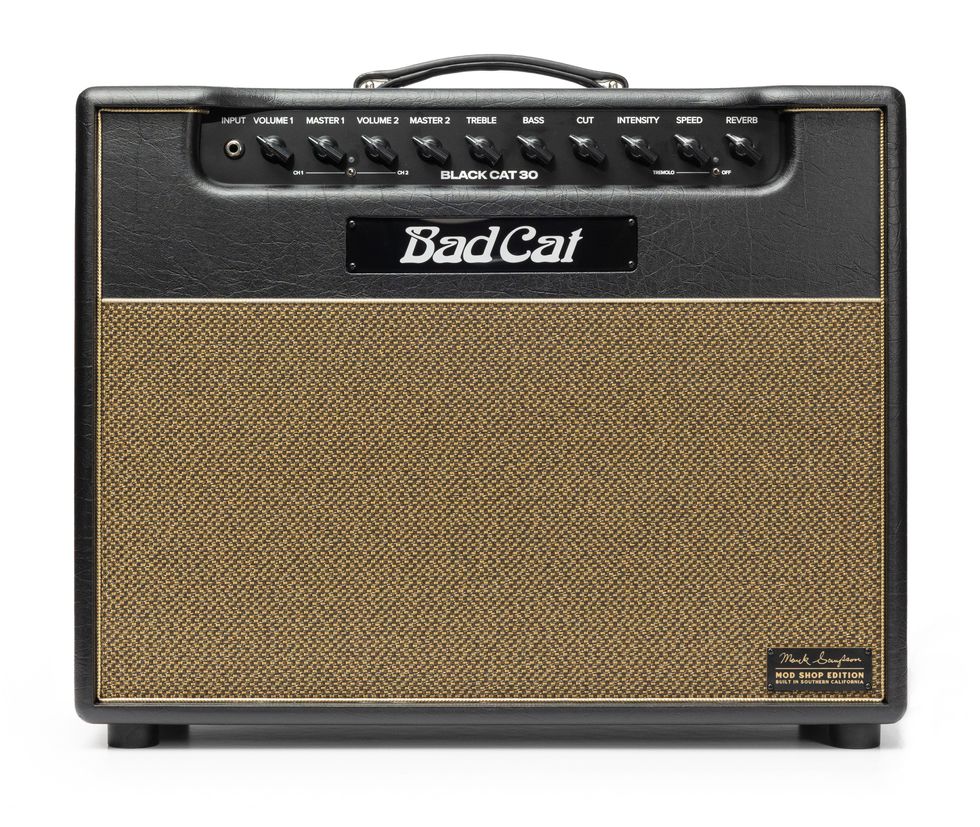
Before his passing, Sampson—co-founder of the boutique amp movement and one of the most respected circuit designers in the industry—collaborated with Bad Cat on a number of designs. Among them was a fresh take on the award-winning Black Cat. The result is a limited amplifier that blends Bad Cat’s signature character with a bigger, bolder voice, infused with Sampson’s distinct approach to tone shaping.
Key Features:
- 30 watts of EL84 Power – Four EL84s provide signature Class A chime, natural compression, and harmonic richness.
- All-new tone stack – Revoiced by Sampson for enhanced openness and dimension.
- Two independent channels – A rich, dynamic clean channel and a punchy, articulate overdrive.
- Studio-quality reverb and analog bias-modulated tremolo – Lush, vintage-inspired depth and movement.
- Built for real-world use – Buffered effects loop, multiple speaker outputs, and a direct line out for cab sims or IRs.
Handcrafted in Costa Mesa, California, the Mod Shop Black Cat 30 is built with premium components, custom hand-wound transformers, and a level of detail worthy of the Mod Shop name.
Combo Specs:
- Custom UK-made 12” Celestion Bad Cat speaker
- Dimensions: 23.75”W x 10.375”D x 19”H
- Weight: 48 lbs.
Head Specs:
- Dimensions: 20.75”W x 10.375”D x 10”H
- Weight: 31 lbs.
Both versions include a two-button footswitch (Channel Select and Tremolo) and come with a 3-year limited warranty.
The Mod Shop Black Cat 30 Head and Combo are available now and carry street prices of $2299 and $2499 respectively. To learn more or place an order, visit www.badcatamps.com
BOSS Announces RT-2 Rotary Ensemble
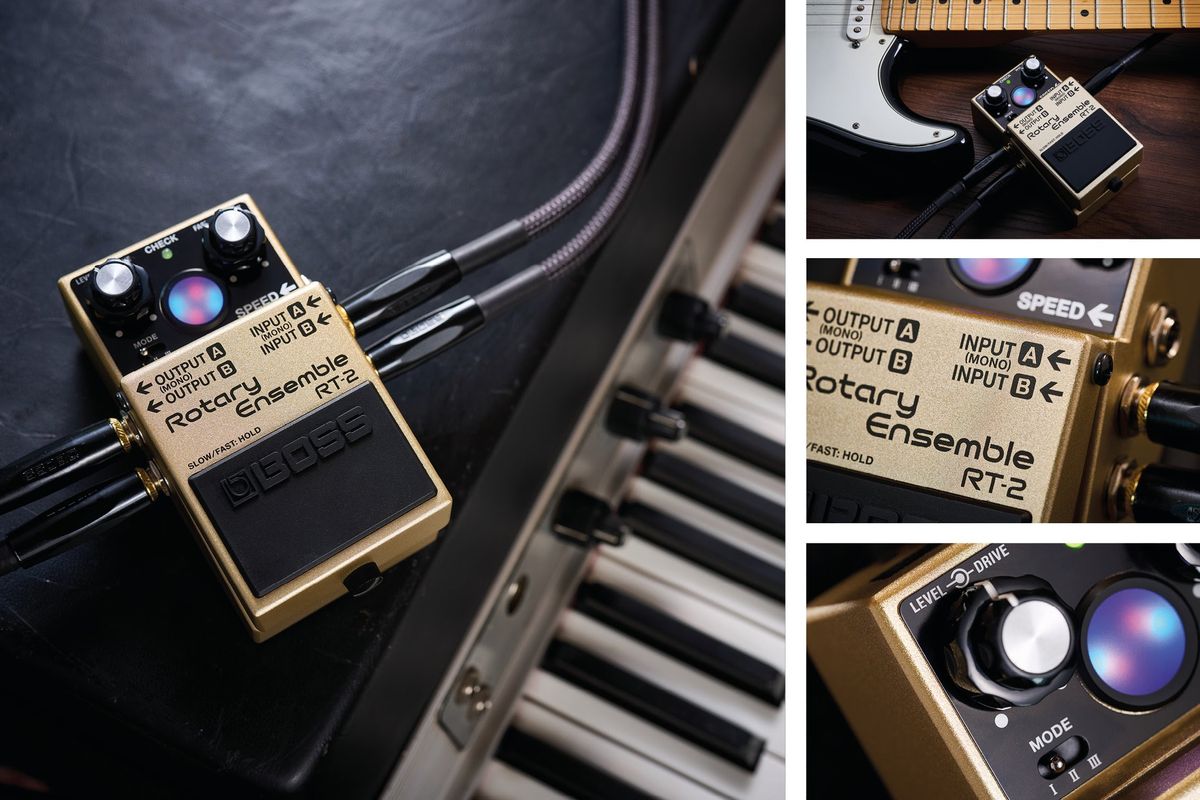
BOSS announces the RT-2 Rotary Ensemble, the latest member of the company’s famous compact pedal lineup. Rotary speaker cabinets are a vital part of the classic combo organ voice, and guitarists and other musicians have also used them to infuse iconic tracks with their distinctive depth and rich modulation. Powered by the latest BOSS advancements, the RT-2 distills this expressive spatial effect into a pedalboard-friendly footprint with three sound modes, deep tonal shaping, multiple audio output configurations, and advanced real-time sound control.
The most revered rotary speaker designs feature a spinning high-frequency horn (treble rotor) and a woofer that feeds into a rotating drum (bass rotor). Changing rotor speeds between fast and slow creates a steady stream of tonal shifts that players have long used for interesting sonic movement. The RT-2 authentically replicates these complex audio behaviors, coupled with two-way speed control, a Rise/Fall Time switch for adjusting the transition time between speeds, and a colorful indicator that shows the current rotation of the virtual rotors.
The versatile RT-2 has a three-position Mode switch for selecting a classic rotary speaker sound or two modern variations developed with custom BOSS tuning. There’s also a Drive knob to add pleasing distortion inspired by the tube amplification circuits in vintage rotary speaker cabinets. Via a rear-panel switch, this dual-function control can be assigned to adjust the volume balance between the treble and bass rotors for different tonal characteristics.
Real-time speed control is essential to the rotary experience, and the RT-2 includes many options to achieve it. The pedal switch offers four operation types with clever ways to bypass the effect and change speeds while performing. Connecting external footswitches provides independent speed control and access to a “brake” setting that stops the virtual rotors at their current positions for unique tones. Alternately, an expression pedal unlocks continuous control of level, drive, balance, and speed, complete with assignable settings for each parameter.
To learn more about the RT-2 Rotary Ensemble, visit https://www.boss.info.Availability & Pricing
The BOSS RT-2 Rotary Ensemble will be available in July 2025, for $239.99.
George Alessandro Asks: Are You Using Your Amp’s Standby Switch Correctly?
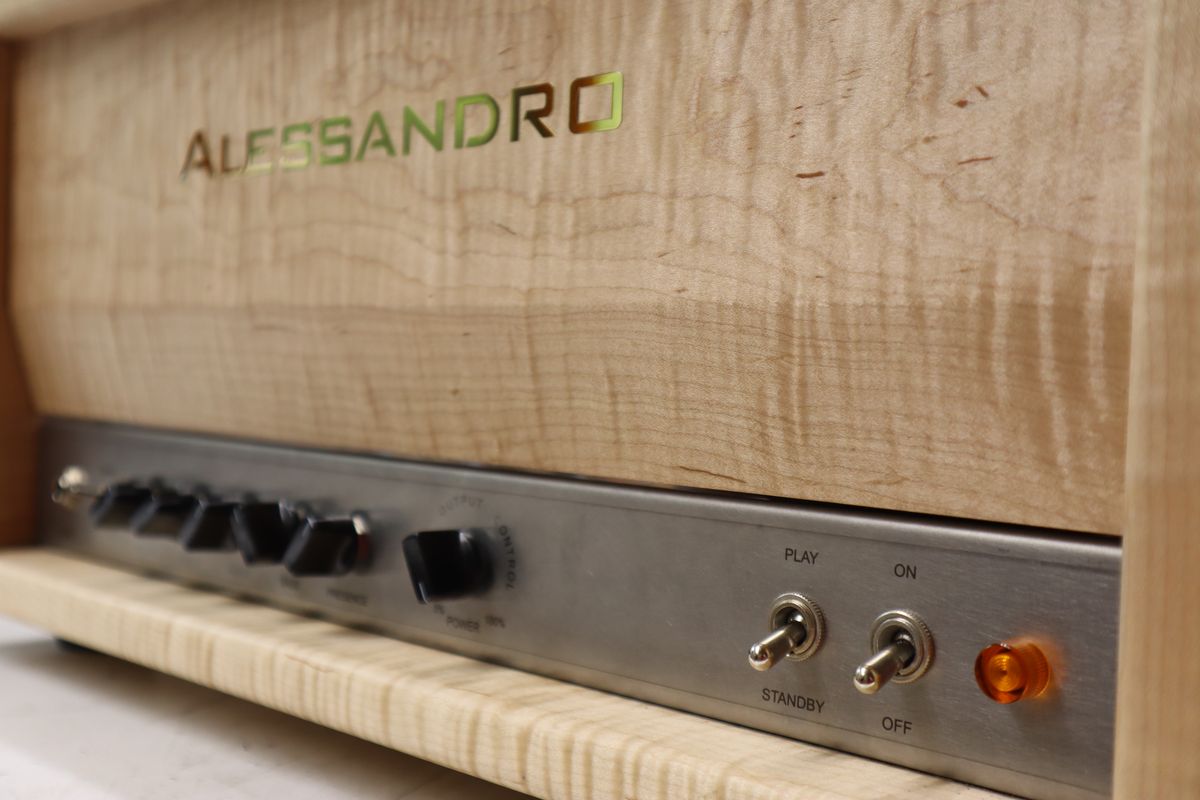
“To standby or not to standby, that is the question”
Are you using your standby switch correctly? Are you sure? It might be a little different than you think.
You have your on/off switch and, well, that makes sense. But standby? Okay, well, what is the flip side? In a tube guitar amplifier, it is “play.” Isn’t the flip side of “off” also play? Why are there two switches that do basically the same thing? Vacuum tube amps are a very old electronic technology, and there is a specific function for each of the two switches.
The on/off switch controls power to the entire amplifier by switching the line voltage on or off to the power transformer. The power transformer is the distribution hub for the energy inside the amp. If your amp doesn’t have a standby switch, then once you switch it on, all the energy is on inside the amp all at once. This isn’t a good thing for vacuum tubes. They need to warm up before they can function, which is why you get no sound from a tube amp when you first turn it on. Tubes only need about 45–60 seconds to warm up to function, but they do sound different and “better” once they get up to operating temperature. This can take five to 10 minutes, and once you actually start playing the amp and they get cooking, even more time to get that tone!
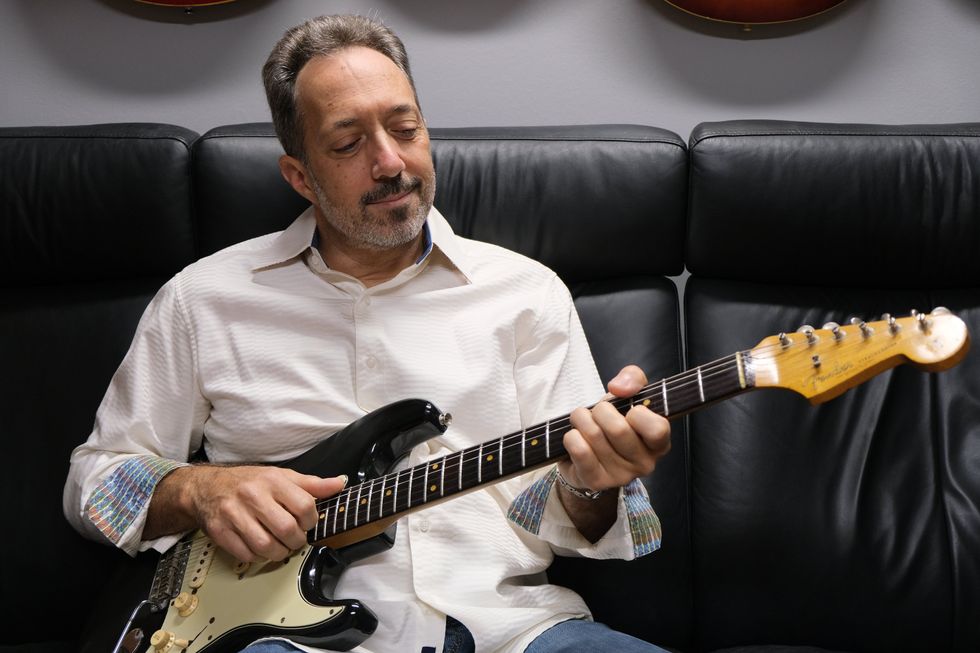
So the standby switch has a few functions. At cold start up, it allows the tubes time to warm up before applying the high voltage to them to operate the amp. While the amp is at operating temperature, if you are taking a break, it allows the amp to also take a break while maintaining operating temperature. And at the end of the session, it allows you to discharge the energy inside the amp. Here are the times you’ll use that switch:
Cold start
With the standby on, turn the power switch on. Allow the amp to warm up for a minute, then flip the standby to “play” position. There is no issue with waiting more than a minute, but shorter is bad. There is this thing called cathode stripping that happens when you apply voltage to a tube before it is fully warmed up.
In between sets or just taking a break.
You probably know how hot your amp gets when you’re jamming away. This is okay; tubes run on high temperatures, but all the other parts inside, not so much. So, give the amp a break. When you’re taking a break, switch to standby position. This keeps the tube warm but allows the entire amp to cool down. This also takes the high voltage off the circuit, so the parts’ life clock is put on hold, too. If you’re going for a long break, an hour or more, you can do a full shutdown and start from the cold-start procedure. Otherwise, you’re just wasting energy heating the tubes and the heaters do have a life span.
Shut down.
So far, it’s likely everything seems obvious. But here’s where people can get it wrong: It’s the end of the night, and you’re drained and done. Well, your amp wants to be too! Shutdown is a slightly different procedure than taking a break and allows the amp to drain all its stored voltages. After that last note, flip that on/off switch onto the off position. You can audibly hear the energy drain out of the amp as the last of the high voltage is dissipated by the tubes trying to operate, because the standby switch is still in the play position. The off position shuts down the heaters inside the tubes and the high voltage, so the last of the energy stored by the caps can drain out while the tubes are still hot. When you hear the last of that sound dissipate, the voltage inside is drained, and you can put the standby switch onto standby. Now, the amp is ready for the cold start up procedure.
What about amps that don’t have standby switches? They don’t need it. The Princeton Reverb, for example, doesn’t have a standby switch, but it does have a 5AR4 rectifier tube. The 5AR4/GZ34 tube has a controlled warm up. While the tube is cold, it will not pass high voltage for a set amount of time, about 45 seconds. This controlled warm up allows all the tubes in the amp to get warm before the high voltage comes on. So, it does the waiting to go from standby to play for you. You don’t have the take a break option anymore, so it is best to shut it down when taking long breaks. It automatically does the cold turn on and aforementioned shut down procedure.
But if your amp has a standby switch, use it!




